Class 10 Science Chapter 6 Life Processes NCERT Solutions
Before getting into the details of NCERT Solutions For Class 10 Science Chapter 6 Life Processes, let’s have an overview of topics and subtopics under class 10 science chapter 6 activities solutions:
- Life Processes
- What Are Life Processes?
- Nutrition
- Respiration
- Transportation
- Excretion
Free download NCERT Solutions for Class 10 Science Chapter 6 Life Processes PDF in Hindi Medium as well as in English Medium for CBSE, Uttarakhand, Bihar, MP Board, Gujarat Board, and UP Board students, who are using NCERT Books based on updated CBSE Syllabus for the session 2019-20.
- जैव-प्रक्रम कक्षा 10 विज्ञान हिंदी में
- Life Processes Class 10 Notes
- Life Processes NCERT Exemplar Solutions
- Life Processes Class 10 Extra Questions
- Class 10 Life Processes Mind Map
NCERT Solutions for Class 10 Science Chapter 6 Intext Questions
Page Number: 95
Question 1
Why is diffusion insufficient to meet the oxygen requirements of multicellular organisms like humans ?
Answer:
In multicellular organisms like humans, all the body cells are not in direct contact with the surrounding environment. Therefore, every cell of the body will not get oxygen as per need by the process of diffusion from the environment. Therefore diffusion is insufficient to meet the oxygen requirements of multicellular organisms.
Question 2
What criteria do we use to decide whether something is alive ?
Answer:
The main criteria used to decide whether something is alive are breathing and respiration. However, living beings also show growth and movement.
Question 3
What are outside raw materials used by an organism ?
Answer:
Any organism uses organic molecules as raw material. Heteroptrophs use food and autotrophs use carbon dioxide, minerals, water and all organisms use oxygen (for respiration) as raw materials.
Question 4
What processes would you consider essential for maintaining life ?
Answer:
Processes essential for maintaining life are :
(i) Nutrition
(ii) Respiration
(iii) Transportation
(iv) Excretion
Page Number: 101
Question 1
What are the differences between autotrophic nutrition and heterotrophic nutrition ?
Answer:
| Autotrophic nutrition | Heterotrophic nutrition |
| (i) In this mode of nutrition an organism makes or synthesizes its own food. | (i) In this mode of nutrition an organism cannot make or synthesize its own food |
| Organisms use simple inorganic materials like carbon dioxide and water and synthesise their food in presence of sunlight. | (ii) Organisms cannot make their own food from simple inorganic matter and depend on other organisms for their food. |
| (iii) All green plants and some algae undergo this mode of nutrition. | (iii) All the animals, most bacteria and fungi undergo this mode of nutrition. |
Question 2
Where do plants get each of the raw materials required for photosynthesis ?
Answer:
(i) Carbon dioxide : Plants get carbon dioxide from the environment/atmosphere through stomata.
(ii) Water : Plants absorb water from the soil through roots and transport to leaves.
(iii) Sunlight : Plants get sunlight from the sun.
(iv) Chlorophyll : It is present in chloroplast found in green leaves and green parts of plants.
Question 3
What is the role of the acid in our stomach ?
Answer:
Role of acid in our stomach is :
(i) To make acidic medium which is necessary for the activation of the enzyme pepsin.
(ii) To kill bacteria which the food may contain.
Question 4
What is the function of digestive enzymes ?
Answer:
The food we eat is complex in nature, i.e., it contains complex molecules. Digestive enzymes break down these complex molecules into smaller simpler molecules so that they can be absorbed by the walls of the intestine.
Question 5
How is the small intestine designed to absorb digested food ?
Answer:
The small intestine is designed to provide maximum area for absorption of digested food and its transfer into the blood for its circulation into the body. For this the inner lining of the small intestine has numerous finger-like projections called villi. The villi are richly supplied with blood vessels which take the absorbed food to each and every cell of the body.
Page Number: 105
Question 1
What advantage over an aquatic organism does a terrestrial organism have with regard to obtaining oxygen for respiration ?
Answer:
Aquatic organisms use oxygen dissolved in surrounding water. Since air dissolved in water has fairly low concentration of oxygen, the aquatic organisms have much faster rate of breathing.
Terrestrial organisms take oxygen from the oxygen-rich atmosphere through respiratory organs. Hence, they have much less breathing rate than aquatic organisms.
Question 2
What are the different ways in which glucose is oxidised to provide energy in various organisms ?
Answer:
First step of breakdown of glucose (6 carbon molecules) takes place in the cytoplasm of cells of all organisms. This process yields a three carbon molecule compound called pyruvate.
Further break down of pyruvate takes place in different ways in different organisms.
(i) Anaerobic respiration : The anaerobic respiration in plants (like yeast) produces ethanol and carbon dioxide as end products.
(ii) Aerobic respiration : In aerobic respiration break down of pyruvate takes place in presence of oxygen to give rise three molecules of carbon dioxide and water. The release of energy in aerobic respiration is much more than in anaerobic respiration.
(iii) Lack of oxygen : Sometimes, when there is lack of oxygen especially during physical exercise, in our muscles, pyruvate is converted into lactic acid (3 carbon molecule compound). Formation of lactic acid in muscles causes cramp.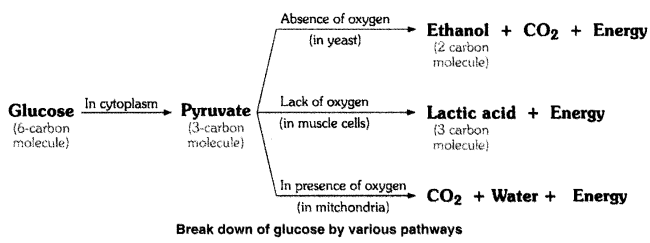
Question 3
How is oxygen and carbon dioxide transported in human beings ?
Answer:
(i) Transport of oxygen : Haemoglobin present in the blood takes up the oxygen from the air in the lungs. It carries the oxygen to tissues which are deficient in oxygen before releasing it.
(ii) Transport of carbon dioxide : Carbon dioxide is more soluble in water. Therefore, it is mostly transported from body tissues in the dissolved form in our blood plasma to lungs. Here it diffuses from blood to air in the lungs.
Question 4
How are the lungs designed in human beings to maximise the area for exchange of gases ?
Answer:
Within the lungs, the air passage divides into smaller and smaller tubes, called bronchi which in turn form bronchioles. The bronchioles terminate in balloon-like structures, called alveoli. The alveoli present in the lungs provide maximum surface for exchange of gases. The alveoli have vary thin walls and contain an extensive network of blood vessels to facilitate exchange of gases.
Page Number: 110
Question 1
What are the components of the transport system in human beings ? What are the functions of these components ?
Answer:
The transport system (circulatory system) in human beings mainly consists of heart, blood and blood vessels.
(i) Function of heart : The heart receives deoxygenated blood from the body parts and pumps it to lungs for enriching with oxygen. It receives purified blood from lungs and pumps it around the body.
(ii) Function of blood : Blood transports oxygen, carbon dioxide, digested food, hormones and nitrogeneous waste like urea. It also protects the body from diseases and regulates the body temperature.
(iii) Function of blood vessels : The blood pushed by the heart flows through the blood vessels (arteries, veins and capillaries) and also comes back to the heart through them.
Question 2
Why is it necessary to separate oxygenated and deoxygenated blood in mammals and birds ?
Answer:
Separation of oxygenated and deoxygenated blood allows good supply of oxygen to the body. This system is useful in animals that have high energy requirement. Mammals and birds constantly need oxygen to get energy to maintain their body temperature constant.
Question 3
What are the components of the transport system in highly organised plants?
Answer:
In highly organised plants there are two conducting tissues xylem and phloem.
Xylem consists of vessels, tracheids and other xylem tissues. The interconnected vessels and tracheids form a continuous system of water conducting channels reaching all parts of the plant. Xylem carries water and minerals.
Phloem conducts soluble products of photosynthesis from leaves to different parts of the plant body.
Question 4
How are water and minerals transport in plants ? [AICBSE 2015]
Answer:
The roots of a plant have hair called root hair.
The root hair are directly in contact with the film of water in between the soil particles. Water and dissolved minerals get into the root hair by the process of diffusion. The water and minerals absorbed by the root hair from the soil pass from cell to cell by osmosis through the epidermis, root cortex, endodermis and reach the root xylem.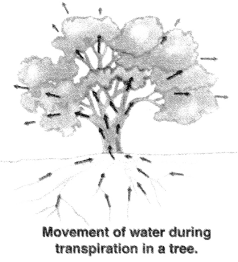
The xylem vessels of the root of the plant are connected to the xylem vessels of its stem.
Therefore the water containing dissolved minerals enters the root xylem vessels into stem xylem vessels. The xylem vessels of the stem branch into the leaves of the plants. So, the water and minerals carried by the xylem vessels in the stem reach the leaves through the branched xylem vessels which enter from the petiole (stalk of the leaf) into each and every part of the leaf. Thus the water and minerals from the soil reach through the root and stem to the leaves of the plants. Evaporation of water molecules from the cells of a leaf creates a suction which pulls water from the xylem cells of roots. The loss of water in the form of vapour from the aerial parts of the plant is known as transpiration.
Question 5
How is food transported in plants ?
Answer:
The movement of food in phloem (or translocation) takes place by utilizing energy. The sugar (food) made in leaves is loaded into the sieve tubes of phloem tissue by using energy from ATR Water now enters the sieve tubes containing sugar by the process of osmosis due to which the pressure in the phloem tissue rises. This high pressure produced in the phloem tissue moves the food to all parts of the plant having less pressure in their tissues. This allows the phloem to transport food according to the needs of the plant.
Page Number: 112
Question 1
Describe the structure and functions of nephrons.
Answer:
Structure of nephron : Each nephron is composed of two parts. First one is a cup-shaped bag at its upper end which is called Bowman’s capsule.
The Bowman’s capsule contains a bundle of blood capillaries which is called glomerulus. One end of the glomerulus is attached to the renal artery which brings the impure blood containing the urea waste into it. These impurities are filtered. The other part of the nephron is coiled. In this part, the substances like sugar (glucose), amino acid, ions and excess water which are required by the body, are reabsorbed. The substance remained in the nephron is mainly urine containing dissolved urea in water which is expelled from the body through urethra from time to time.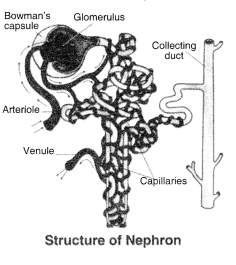
Functions of nephron : Filtration of blood takes place in Bowman’s capsule from the capillaries of glomerulus. The filtrate passes into the tubular part of the nephron. This filtrate contains glucose, amino acids, urea, uric acid, salts and water.
Reabsorption : As the filtrate flows along the tubule, useful substances such as glucose, amino acids, salts and water are selectively reabsorbed into the blood by capillaries surrounding the nephron tubule.
Urine : The filtrate which remained after reabsorption is called urine. Urine contains dissolved nitrogenous waste like urea and uric acid, excess salts and water. Urine is collected from nephrons to carry it to the ureter from where it passes into urinary bladder.
Question 2
What are the methods used by plants to get rid of excretory products ?
Answer:
(i) The plants get rid of gaseous products-through stomata in leaves and lenticels in stems.
(ii) The plants get rid of stored solid and liquid waste by the shedding off leaves, peeling off bark and felling off fruits.
(iii) The plants get rid of wastes by secreting them in the form of gums and resins.
(iv) Plants also excrete some waste substances into the soil around them.
Question 3
How is the amount of urine produced regulated ?
Answer:
The amount of urine is regulated by kidney. It depends on the quantity of excess water and wastes dissolved in water.
(i) Quantity of water : When water is abundant in the body tissues, large quantities of dilute urine is excreted out. When water is less in quantity in the body tissues, a small quantity of concentrate urine is excreted.
(ii) Quantity of dissolved wastes : Dissolved wastes, especially nitrogenous wastes, like urea and uric acid and salts are excreted from the body. When there is more quantity of dissolved wastes in the body, more quantity of water is required to excrete them. Therefore, the amount of urine produced increases.
(iii) Hormones : The amount of urine produced is also regulated by certain hormones which control the movement of water and Na+ ions in and out of the nephrons.
NCERT Solutions for Class 10 Science Chapter 6 Textbook Chapter End Questions
Question 1
The kidneys in human beings are a part of the system for
(i) nutrition
(ii) respiration
(iii) excretion
(iv) transportation
Answer:
(iii) Excretion
Question 2
The xylem in plants are responsible for
(i) transport of water
(ii) transport of food
(iii) transport of amino acids
(iv) transport of oxygen
Answer:
(i) Transport of water
Question 3
The autotrophic mode of nutrition requires
(i) carbon dioxide and water
(ii) chlorophyll
(iii) sunlight
(iv) all of the above
Answer:
(iv) All of the above
Question 4
The breakdown of pyruvate to give carbon dioxide, water and energy takes place in
(i) cytoplasm
(ii) mitochondria
(iii) chloroplast
(iv) nucleus
Answer:
(ii) Mitochondria
Question 5
How are fats digested in our bodies ? Where does this process take place ?
Answer:
Digestion of fats takes place in the small intestine.
Bile juice secreted by the liver poured in the intestine along with pancreatic juice. The bile salts present in the bile juice emulsify fhe large globules of fats. Therefore, by enulsification large globules break down into fine globules to provide larger surface area to act upon by the enzymes.
Lipase enzyme present in the pancreatic juice causes break down of emulsified fats. Glands present in the wall of small intestine secrete intestinal juice which contains lipase enzyme that converts fats into fatty acids and glycerol.
Question 6
What is the role of saliva in the digestion of food ?
Answer:
Saliva contains salivary amylase enzyme that breaks down starch into sugars like maltose.![]()
Saliva keeps the mouth cavity clean and moistens the food that help in chewing and breaking down the big pieces of food into smaller ones.
Question 7
What are the necessary conditions (or autotrophic nutrition and what are its by-products ?
Answer:
Necessary conditions for autotrophic nutrition :
(i) Presence of chlorophyll in the living cells.
(if) Provision of supply of water to green plants or cells of the plant.
(iii) Sufficient sunlight.
(iv) Sufficient supply of carbon dioxide.
By-product of auto tropic nutrition is oxygen.
Question 8
What are the differences between aerobic and anaerobic respiration ? Name some organisms that use the anaerobic mode of respiration.
Answer:
| Aerobic respiration | Anaerobic respiration |
| 1. It takes place in the presence of oxygen. | 1. It takes place in the absence of oxygen. |
| 2. Complete breakdown of food occurs in aerobic respiration. | 2. Partial breakdown of food occurs in anaerobic respiration. |
| 3. The end products in aerobic respiration are carbon dioxide and water. | 3. The end products in anaerobic respiration may be ethanol and carbon dioxide (as in yeast plants) or lactic acid (as in animal muscles). |
| 4. Aerobic respiration produces a considerable amount of energy. | 4. Much less energy is produced in anaerobic respiration. |
Some organisms which use anaerobic respiration are yeast, bacteria etc.
Question 9
How are the alveoli designed to maximise the exchange of gases ?
Answer:
(i) The alveoli are thin walled and richly supplied with a network of blood vessels to facilitate exchange of gases between blood and the air filled in alveoli.
(ii) Alveoli have balloon-like structure. Hence, provide maximum surface for exchange of gases.
Question 10
What would be the consequences of a deficiency of haemoglobin in our bodies?
Answer:
Due to the deficiency of haemoglobin in blood, its oxygen carrying capacity decreases. As a result the production of energy by oxidation will become slower. Therefore, one would fall sick and would feel fatigue most of the time.
Question 11
Describe double circulation in human beings. Why is it necessary ?
Answer:
In our heart blood enters twice and also pumped out twice from the heart. The deoxygenated blood from the body is brought to the right atrium through vena cava from where it is sent to right ventricle. From right ventricle, the blood is pumped to the lungs for oxygenation through pulmonary artery. The oxygenated blood from lungs again enters the left atrium of the heart through pulmonary veins. From left atrium it is send to left ventricle, from where this oxygenated blood is pumped to different parts of body through the arteries. In this way the blood flows through the heart twice, that’s why it is called ‘double circulation’.
Necessity of double circulation: The right side and the left side of the human heart are useful to keep deoxygenated and oxygenated blood from mixing. This type of separation of oxygenated and deoxygenated blood ensures a highly efficient supply of oxygen to the body. This is useful in case of humans who constantly need energy to maintain their body temperature.
Question 12
What are the differences between the transport of materials in xylem and phloem ?
Answer:
| Xylem | Phloem |
| 1. Xylem conducts water and dissolved minerals from roots to leaves and other parts. | 1. Phloem conducts prepared food material from leaves to other parts of plant in dissolved form. |
| 2. In xylem, the transport of material takes place through vessels and tracheids which are dead tissues. | 2. In phloem, transport of material takes place through sieve tubes with the help of companion cells, which are living cells. |
| 3. In xylem upward movement of water and dissolved minerals is mainly achieved by transpiration pull. It is caused due to suction created by evaporation of water molecules from the cells of a leaf. | 3. In translocation, material is transferred into phloem tissue using energy from ATP. This increases the osmotic pressure that moves the material in the phloem to tissues which have less pressure |
Question 13
Compare the functioning of alveoli in the lungs and nephrons in the kidneys with respect to their structure and functioning.
Answer:
| Alveoli | Nephron |
| 1. Alveoli are functional unit of lungs. | 1. Nephrons are functional unit of kidney. |
| 2. A mature lung has about 30 crore alveoli. | 2. A kidney has about 10 lakh nephrons. |
| 3. Alveoli provide a wide surface for gaseous exchange. | 3. The surface area of a nephron is not much more. |
| 4. The exchange of O2 and CO2 takes place through the network of capillaries in alveoli. | 4. The Bowman’s capsule in nephron regulates the concentration of water and salts. |
NCERT Solutions for Class 10 Science Chapter 6 Life Processes
Life processes: ‘Living being’. Basic concept of nutrition, respiration, transport and excretion in plants and animals.
| Board | CBSE |
| Textbook | NCERT |
| Class | Class 10 |
| Subject | Science |
| Chapter | Chapter 6 |
| Chapter Name | Life Processes |
| Number of Questions Solved | 34 |
| Category | NCERT Solutions |
Question 1
How are fats digested in our bodies? Where does this process take place?
Solution:
The small intestine is the site of the complete digestion of carbohydrates, proteins and fats. It receives the secretions of the liver and pancreas for this purpose. The food coming from the stomach is acidic and has to be made alkaline for the pancreatic enzymes to act. Bile juice from the liver accomplishes this in addition to acting on fats. Fats are present in the intestine in the form of large globules, which make it difficult for enzymes to act on them. Bile salts break them down into smaller globules increasing the efficiency of enzyme action. The pancreas secretes pancreatic juice, which contains enzymes like trypsin for digesting proteins and lipase for breaking down emulsified fats. The walls of the small intestine contain glands, which secrete intestinal juice. The enzymes present in it finally convert the proteins to amino acids, complex carbohydrates into glucose and fats into fatty acids and glycerol.
Question 2
What is the role of saliva in the digestion of food?
Solution:
When we eat something we like, our mouth ‘waters’. This is actually not only water, but also a fluid called saliva secreted by the salivary glands. Another aspect of the food we ingest is its complex nature. If it is to be absorbed from the alimentary canal, it has to be broken into smaller molecules. This is done with the help of biological catalysts called enzymes. The saliva contains an enzyme called salivary amylase that breaks down starch, which is a complex molecule to give sugar. The food is mixed thoroughly with saliva and moved around the mouth while chewing by the muscular tongue.
Question 3
What are the necessary conditions for autotrophic nutrition and what are its byproducts?
Solution:
Carbon and energy requirements of the autotrophic organism are fulfilled by photosynthesis. It is the process by which autotrophs take in substances from the outside and convert them into stored forms of energy. This material is taken in the form of carbon dioxide and water, which is converted into carbohydrates in the presence of sunlight and chlorophyll. Carbohydrates are utilised for providing energy to the plant. The carbohydrates, which are not used immediately, are stored in the form of starch, which serves as the internal energy reserve to be used as and when required by the plant.
Question 4
What are the differences between aerobic and anaerobic respiration? Name some organisms that use the anaerobic mode of respiration.
Solution:
The food material taken in during the process of nutrition is used in cells to provide energy for various life processes. Diverse organisms do this in different ways – some use oxygen to breakdown glucose completely into carbon dioxide and water; some use other pathways that do not involve oxygen. In all cases, the first step is the breakdown of glucose, a six-carbon molecule, into a three-carbon molecule called pyruvate. This process takes place in the cytoplasm. Further, the pyruvate may be converted into ethanol and carbon dioxide. This process takes place in yeast during fermentation. Since this process takes place in the absence of air (oxygen), it is called anaerobic respiration. Breakdown of pyruvate using oxygen takes place in the mitochondria. This process breaks up the three-carbon pyruvate molecule to give three molecules of carbon dioxide. The other product is water. Since this process takes place in the presence of air (oxygen), it is called aerobic respiration. The release of energy in this aerobic process is a lot greater than in the anaerobic process.
Question 5
How are the alveoli designed to maximise the exchange of gases?
Solution:
Within the lungs, the passage divides into smaller and smaller tubes, which finally terminate in balloon-like structures, which are called alveoli. The alveoli provide a surface where the exchange of gases can take place. The walls of the alveoli contain an extensive network of blood vessels. As we have seen in earlier years, when we breathe in, we lift our ribs and flatten our diaphragm, and the chest cavity becomes larger as a result. Because of this, air is sucked into the lungs and fills the expanded alveoli. The blood brings carbon dioxide from the rest of the body for release into the alveoli, and the oxygen in the alveolar air is taken up by blood in the alveolar blood vessels to be transported to all the cells in the body. During the breathing cycle, when air is taken in and let out, the lungs always contain a residual volume of air so that there is sufficient time for oxygen to be absorbed and for the carbon dioxide to be released.
Question 6
Describe double circulation in human beings. Why is it necessary?
Solution:
The double circulatory system of blood flow refers to the separate systems of pulmonary circulation and the systemic circulation.
The adult human heart consists of two separated pumps, the right side with the right atrium and ventricle which pumps deoxygenated blood into the pulmonary circulation.
The oxygenated blood re-enters the left side of the heart through the pulmonary vein into the left atrium and passes to the left ventricle where it is pumped to the rest of the body. This part of the circulation is called as systemic circulation. This type of circulation is called double circulation. The advantage of a double circulatory system is that blood can be pumped to the rest of the body at a higher pressure.
Multiple Choice Questions (MCQs) [1 Mark each]
Question 1.
Yeast respires anaerobically using sugar as a substrate. Out of the options given below, choose the correct combination of condition and product?
| Condition | Product | |
| (a) | Aerobic | Alcohol |
| (b) | Aerobic | Lactic acid |
| (c) | Anaerobic | Alcohol |
| (d) | Anaerobic | Lactic acid |
Answer:
(c) Under an aerobic condition, yeast respires and converts glucose to alcohol and CO2.
Question 2.
The table shows the percentage composition of four samples of air. Which sample could have been breathed out by a person after vigorous exercise?
| Samples | Oxygen | Carbondioxide | Water Vapour |
| (a) | 16 | 0.3 | Saturated |
| (b) | 16 | 4 | Saturated |
| (c) | 21 | 0.03 | Trace |
| (d) | 21 | 3 | Trace |
Answer:
(b) This is because rapid aerobic respiration occurs – during vigorous exercise in order to obtain more energy.
Question 3.
Cramps caused during sudden activities are due to the formation of
(a) lactic acid
(b) acetic acid
(c) excess of water
(d) ethanol
Answer:
(a) Lactic acid is formed by the breakdown of pyruvate when oxygen is insufficient in muscles instead of forming C02 and water. Accumulation of excess lactic acid in the muscles causes cramps.
Question 4.
Which of the following plays nose like function in plants?
(a) Flower
(b) Phloem
(c) Stomata
(d) Chlorophyll
Answer:
(c) Stomata are pores which help in the passage of air in the plants.
Question 5.
Which changes occur when a person breathe in deeply?
| Diaphragm Muscle | External Intercostal Muscles | |
| (a) | Contracts | Contract |
| (b) | Contracts | No change |
| (c) | Relaxes | Contract |
| (d) | Relaxes | Relax |
Answer:
(a) When a person breathes deeply the external intercostal muscles contract causing the rib cage to swing up and out. Also, the diaphragm contracts and flattens causing the thoracic cavity to increase in volume and decrease in pressure.
Question 6.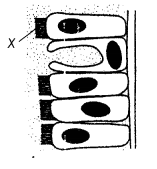
The diagram given above shows part of the lining of the human trachea. What is the function of X?
(a) Gaseous exchange
(b) Mucus removal
(c) Phagocytosis
(d) Secretion of mucus
Answer:
(b) The cilia (X) of the cells lining the air passages move in a sweeping motion to keep the air passages clean. The constant action of these cilia carry mucus and debris upward into the pharynx where they are swallowed.
Question 7.
The table given below shows the percentage composition of a gas in inspired and in expired air.
| %Composition | |
| Inspired Air | Expired Air |
| 21.0 | 16.0 |
What is the gas?
(a) Carbon dioxide
(b) Nitrogen
(c) Oxygen
(d) Water vapour
Answer:
(c) The gas is oxygen as atmospheric air has approximately 21% of oxygen
NCERT Solutions for Class 10 Science Chapter 6 Life Processes (Hindi Medium)
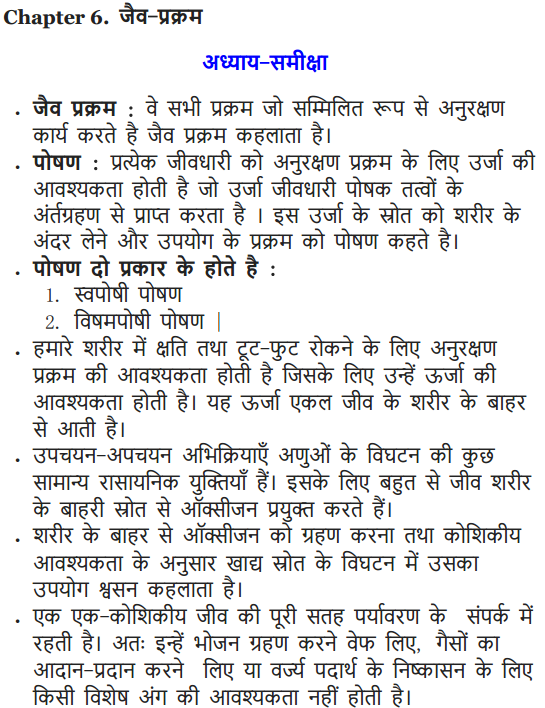
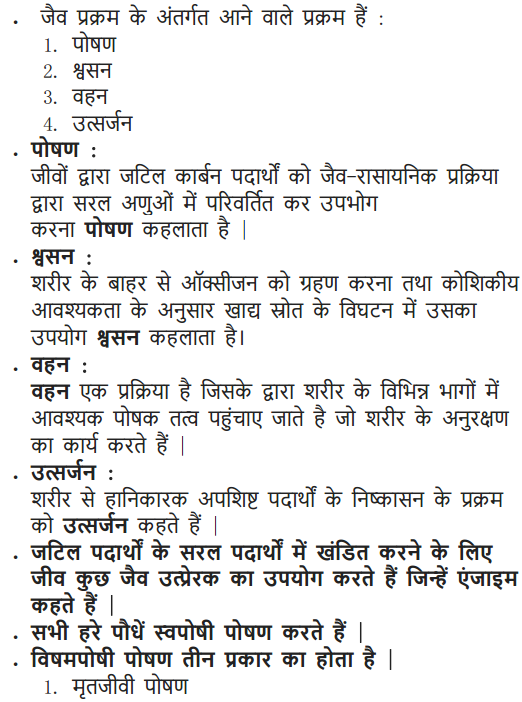
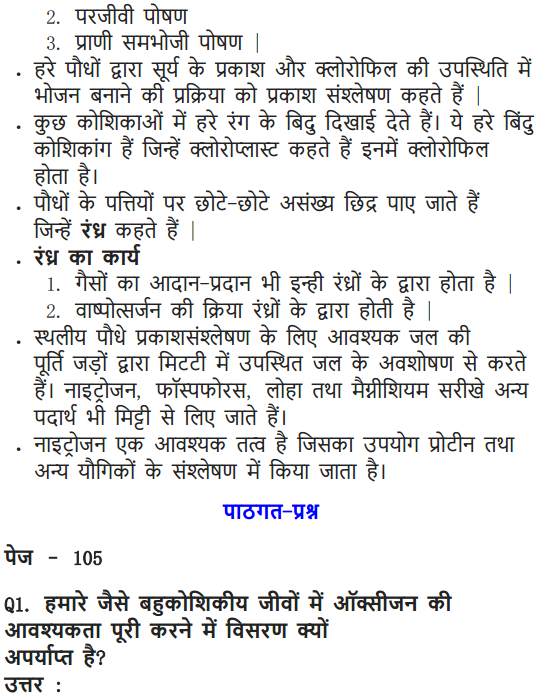
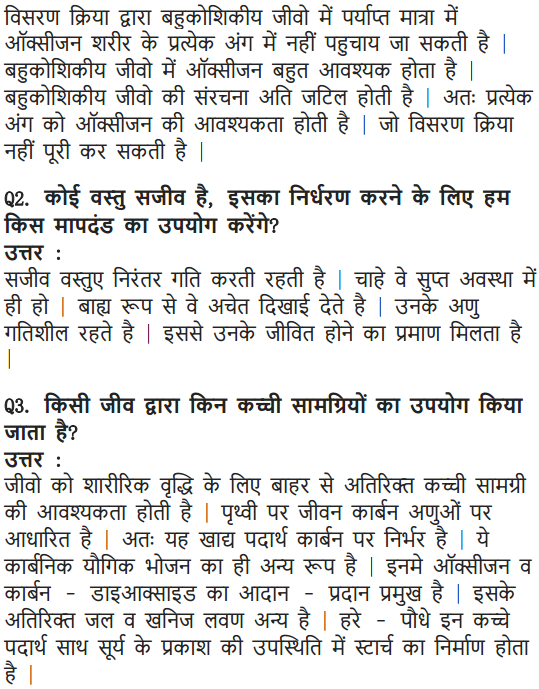
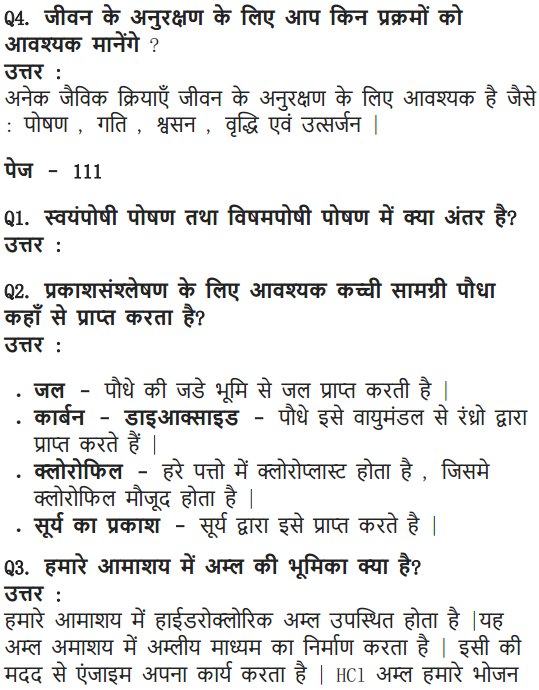
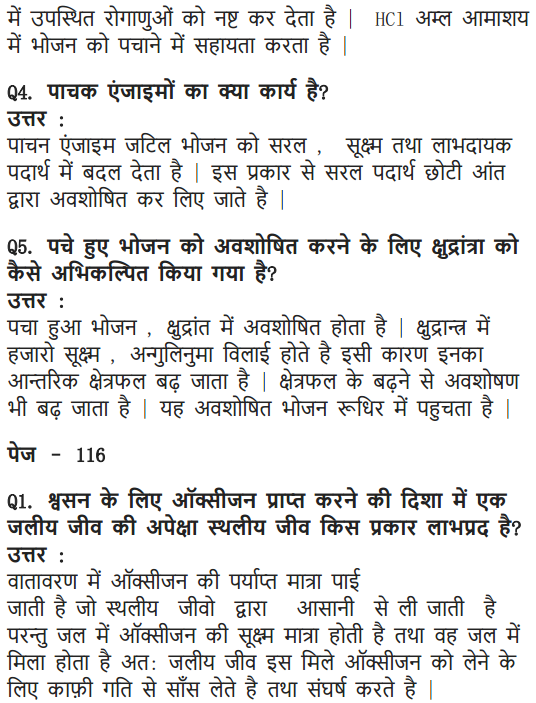
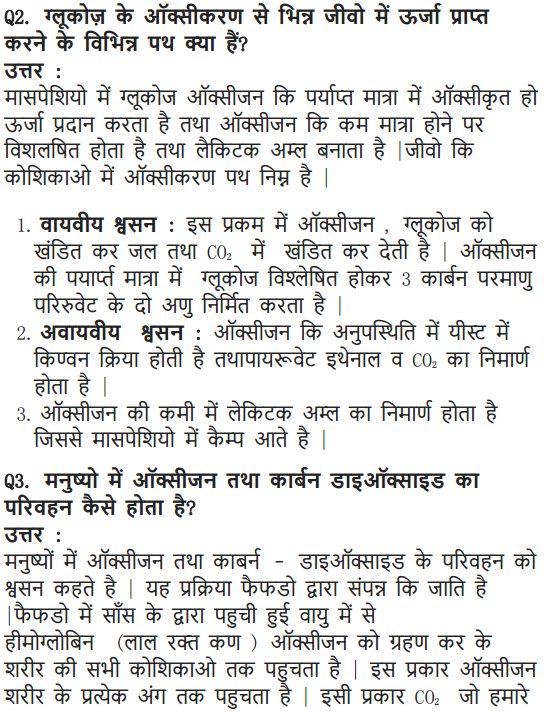
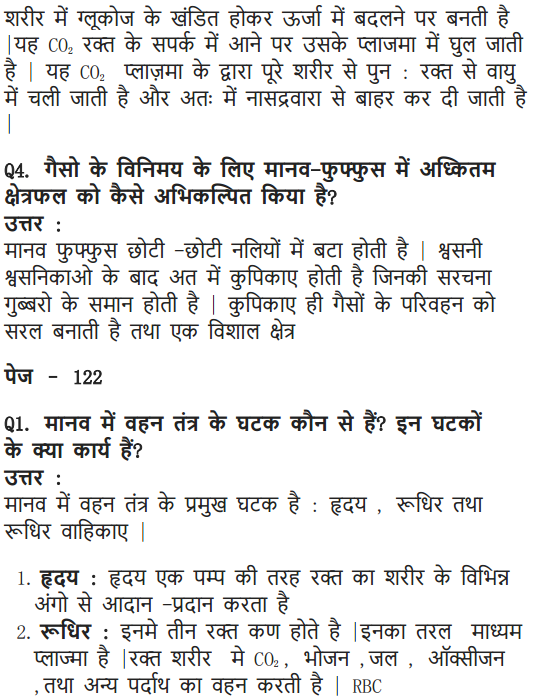
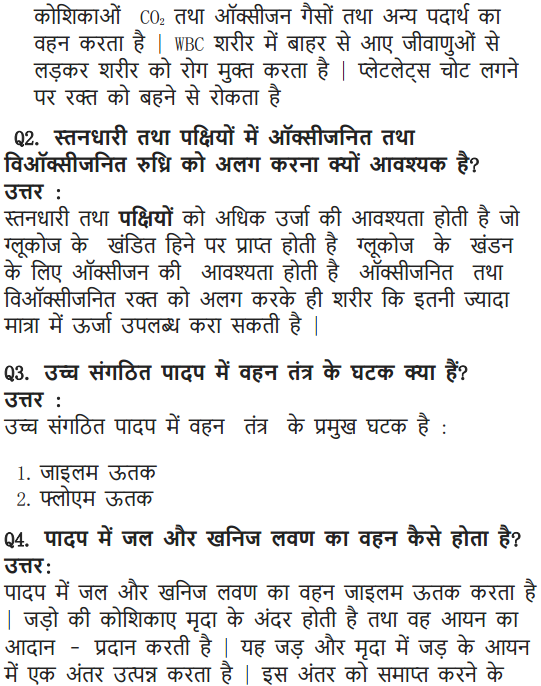
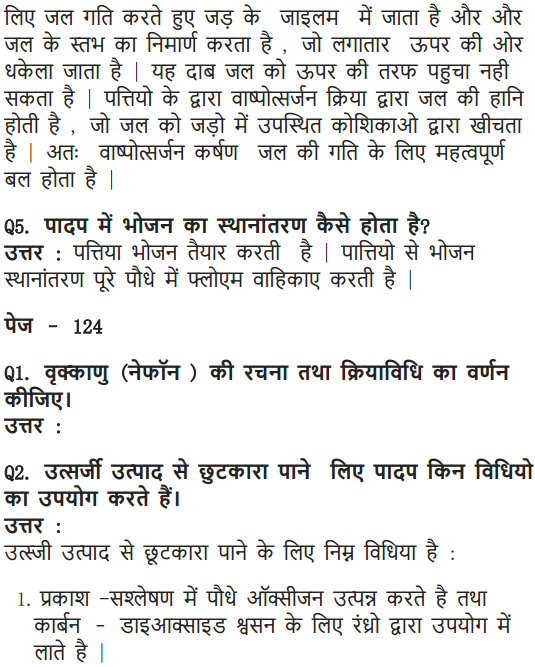
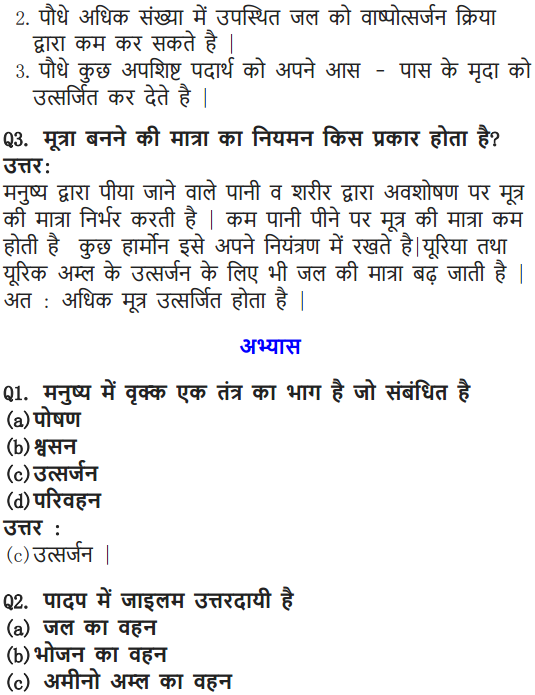
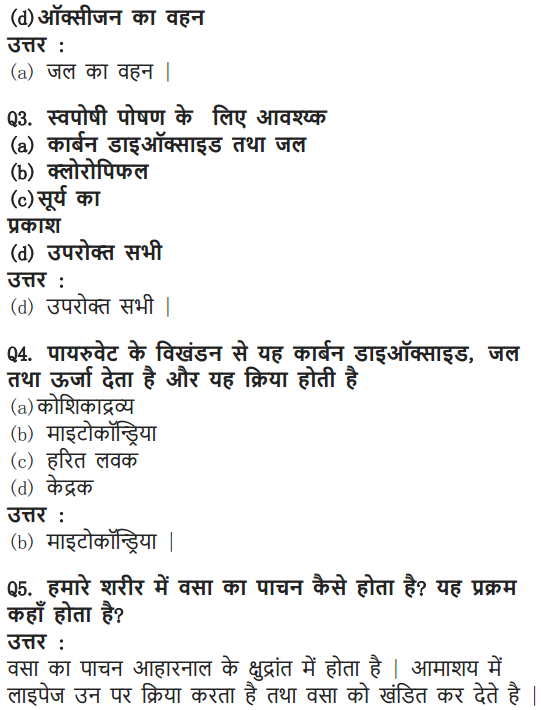
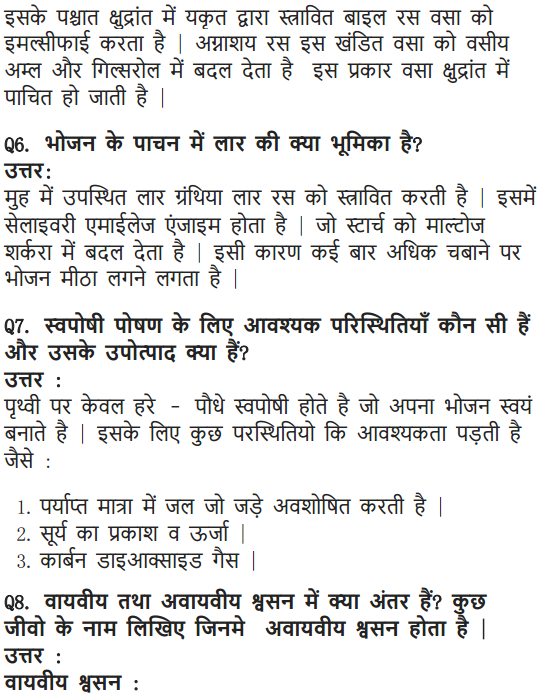
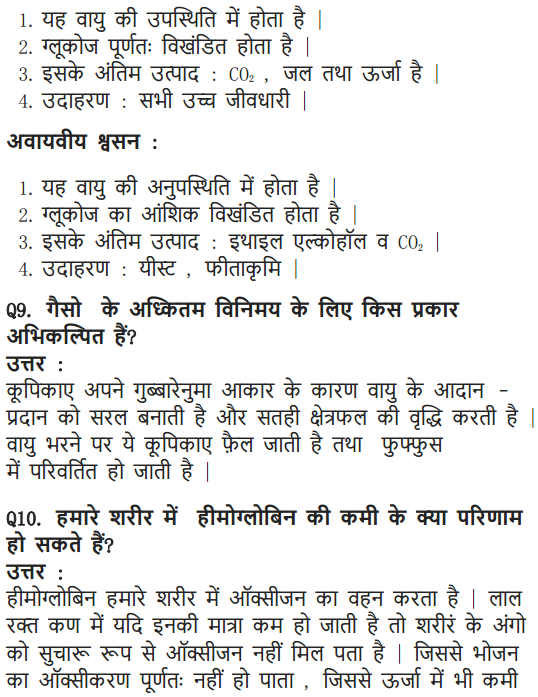
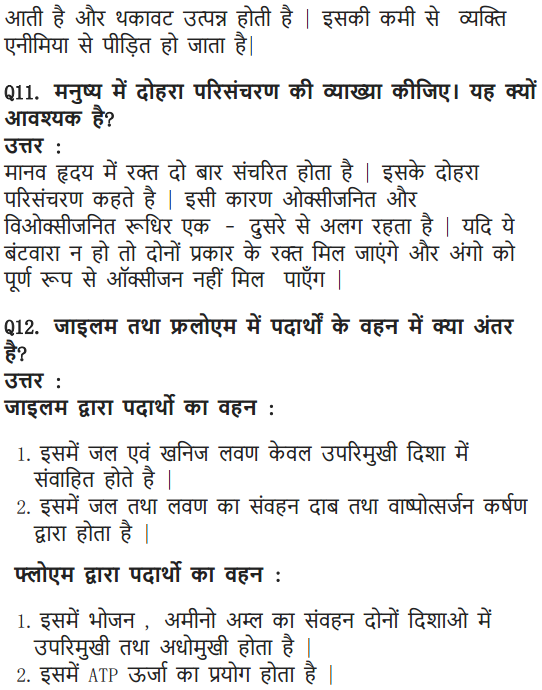
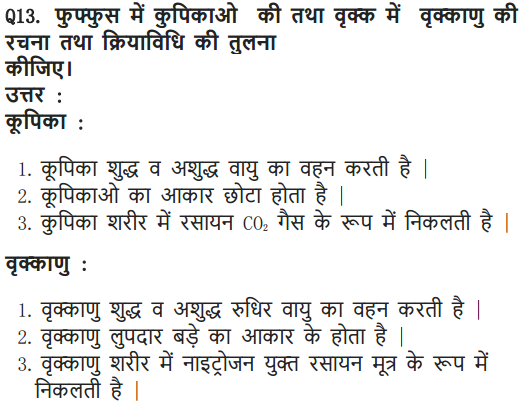
Class 10 Science Life Processes Mind Map
Nutrition
Nutrition is the process by which source of energy (food) is transferred from outside the body of the organism to the inside. Most of the food sources are also carbon-based on Earth and depending on the complexity of these carbon sources different organisms use different kinds of nutritional processes.
Autotrophic Nutrition: Carbon and energy requirements of the autotrophic organism are fulfilled by photosynthesis.
- It is the process by which autotrophs convert carbon dioxide & water into carbohydrate in the presence of sunlight and chlorophyll. Oxygen is the byproduct.
- The following events occur during this process:
- Absorption of light energy by chlorophyll.
- Conversion of light energy to chemical energy and splitting of water molecules into hydrogen and oxygen.
- Reduction of carbon dioxide to carbohydrates.
Heterotrophic Nutrition: Heterotrophs depend on other organisms for their nutrition.
- Saprophytes: They break-down the food material outside the body and then absorb it, also termed as extra-cellular digestion. E.g. fungi like bread moulds, yeast, mushrooms etc.
- Parasites: Derive nutrition from plants or animals without killing them. E.g. cuscuta (amar-bel), ticks, lice, leeches, tape-worms etc.
- Holozoic nutrition: These organisms take in whole material & break it down inside their bodies. E.g. cow, deer, lion, tiger, humans etc. What can be taken in and broken down depends on body design and functioning
Respiration
It is the process by which organism uses the food material to produce energy. Diverse organisms do this in different ways:
Energy released during cellular respiration is immediately used to synthesise ATP which is used to fuel all other activities in the cell. Aerobic organisms need to ensure that there is sufficient intake of oxygen:
• Plants: Exchange of gases takes place through stomata by simple diffusion. Large inter-cellular spaces ensure that all cells are in contact with air. Direction of diffusion depends upon the environmental conditions and the requirements of the plant. For e.g. CO2 elimination majorly takes place at night while oxygen release is the major event of the day time.
• Aquatic animals such as fishes take in water through their mouths & force it past the gills where the dissolved oxygen is taken up by blood.
• In human beings, the passage of air can be written as nostril → trachea → bronchi → bronchioles → alveolar sac. The alveoli provide a surface where the exchange of gases can take place. Blood releases the dissolved CO2 into the alveoli & carries O2 from alveolar air. Haemoglobin in RBC of blood transport O2 from lungs to various tissues of the body.
Life Process
The processes which maintain the body functions and are required for the survival of living being are called life processes. Some of the important life processes are nutrition, respiration, transportation, excretion etc.
Nutrition In Human Beings
The alimentary canal is a long tube extending from the mouth to the anus. The nutrition in human being is divided into five steps:
• Ingestion: Intake of food from outside source. Teeth & saliva crush the food to generate the particles of same size & texture. The food is then passed to stomach via oesophagus. The peristaltic movements occur all along the gut which helps in pushing the food forward.
• Digestion: In mouth, salivary amylase helps in carbohydrates digestion. In stomach, pepsin helps in protein digestion. However, small intestine is the main site of complete digestion of carbohydrates, proteins & fats. It receives pancreas and liver secretions. Bile juice emulsifies fats and pancreatic enzymes, trypsin & lipases digest proteins & emulsified fats. It finally converts proteins to amino acids, complex carbohydrates into glucose & fats into fatty acids & glycerol.
• Absorption: The digested food is taken up by the walls of the intestine. The inner lining of the small intestine has numerous finger-like projections called villi which increase the surface area for absorption. Large intestine absorbs water from the unabsorbed food.
• Assimilation: The villi are richly supplied with blood vessels which take the absorbed food to each & every cell of the body, where it is required either for energy, build up or repair.
• Excretion: The waste material is removed from the body via anus which is regulated by anal sphincter.
Transportation
Transportation in Human Beings
- Blood consists of fluid medium called plasma in which
the cells are suspended. Plasma transports food, CO2 & nitrogenous wastes in dissolved form. Oxygen is carried by RBC. - Heart: Heart is the muscular organ made up of cardiac muscles and is as big as our fist. It is composed of four chambers (2 atria & 2 ventricles) to prevent the mixing of oxygenated & deoxygenated blood.
- Ventricles are thick wailed as they have to pump the blood to various organs of the body. In addition, valves are also present in heart and veins to prevent the backflow of the blood.
Circulation of blood: Oxygenated blood is carried out from lungs to the left atrium with the help of pulmonary’ veins.
- Left atrium contracts to release blood into the left ventricle which relaxes while collecting it. It then pumped out the blood to whole body via aorta.
a Deoxygenated blood from whole body then enters the right atrium via vena cava vein. - Right atrium contracts to pump the blood in right ventricle. It then pumps the blood towards lungs via pulmonary’ artery for oxygenation.
Oxygenation of blood: Invertebrates such as birds, mammals etc which constantly use energy to maintain their body temperature, blood goes through heart twice during each cycle which is known as double circulation.
- In contrast, animals like amphibians or many reptiles have three-chambered hearts as they can tolerate some mixing of the oxygenated & de-oxygenated blood streams. They do not use energy for thermoregulation and body temperature depends on the temperature in the environment.
- Fishes, on other hand, have only two chambered heart. Blood is pumped to the gills for oxygenation and passes directly to the rest of the body.
Transportation In Plants
There are two main pathways present in plants: xylem pathway- moves water & minerals from the soil & phloem transports products of photosynthesis from leaves (where they are synthesized) to other parts of the plant.
Transport of Water
- In xylem tissue, vessels and tracheids of roots, stems & leaves are interconnected to form a continuous system of water-conducting channels reaching all parts of the plant.
- At root site, cells actively take up ions from soil which creates concentration gradient. Water then diffuses into the root cells in order to eliminate this gradient.
- It provides steady movement of water into root xylem, creating a column of water that is steadily pushed upwards.
- However, it is not efficient enough to push water over the heights of tall plants.
- So, plants use other method which is known as transpiration to push water upwards. The loss of water in the form of vapour from aerial parts of plant is known as transpiration.
- Evaporation of water molecules from the cells of a leaf creates a suction which pulls water from the xylem cells of roots. It also aids in thermoregulation.
- Transport of food and other substances
- Transport of soluble products of photosynthesis is called translocation.
- The translocation takes place in sieve tubes with the help of adjacent companion cells both in upward & downward directions.
- It utilizes energy (ATP) in contrast to xylem transport.
- Material like sucrose is transferred into phloem tissue using energy from ATP.
- It increases osmotic pressure of tissue causing water to move into it.
- This pressure moves the material in phloem to tissues which have less pressure.
- It allows phloem to move material according to plant’s needs.
Excretion
The biological process involved in removal of harmful metabolic wastes from body is called excretion.
Many unicellular organisms remove these wastes by simple diffusion from body surface into surrounding water. However, complex multi-cellular organisms use specialised organs to perform this function.
Excretion in Human Beings: The excretory system includes pair of kidneys, pair of ureters, urinary bladder & urethra.
- Nephrons are the functional units of kidneys. They are the clusters of thin-walled capillaries. Each cluster is associated with cup-shaped end (Bowmans capsule) of a tube that collects the filtered urine.
- Substance such as glucose, amino acids, salts & a major amount of water are selectively re-absorbed as the urine flows along the tube. The amount of water depends up on amount of excess water & dissolved waste in the body.
- The urine formed in each kidney is carried to urinary bladder by ureter. Urine is stored in urinary bladder until the pressure of the expanded bladder leads to the urge to pass it out through the urethra.
- Excretion in Plants: They get rid of excess water by transpiration.
- Many plant waste products are stored in cellular vacuoles.
- Waste products may be stored in leaves that fall off.
- In addition, some waste products are stored as resins & gums, especially in old xylem.
- Lastly, plants excrete some waste substances into the soil around them.
We hope the detailed information regarding NCERT Solutions For Class 10 Science Chapter 6 Life Processes is helpful. For any query related to NCERT Solutions For Class 10 Science Chapter 6 Life Processes, kindly drop your questions in the comment box below and we will get back to you as soon as possible.
Important Questions of Life Processes Class 10 Science Chapter 6
Question 1.
Most of the digestion and absorption of the food takes place in the
(a) small intestine
(b) liver
(c) stomach
(d) large intestine. (2020)
Answer:
(a) small intestine
Question 2.
Mention the raw materials required for photosynthesis. (Board Term I, 2016)
Answer:
Raw materials required for photosynthesis are carbon dioxide (CO2), water, light and chloroplast.
Question 3.
State the location and function of gastric glands. (Board Term I, 2014)
Answer:
Gastrifc glands are present in the wall of the stomach. They secrete gastric juices containing mucus, protein digesting enzymes pepsin, rennin and hydrochloric acid (HCl).
Question 4.
Name the glands present in the wall of the stomach that release secretions for digestion of food. Write the three components of secretion that are released by these glands. (Board Term I, 2014)
Answer:
Stomach’s muscular wall contains gastric glands. These glands secrete gastric juices which contain dilute hydrochloric acid, mucus and two protein digesting enzymes rennin and pepsin.
Question 5.
Complete the following flow chart as per the given instructions.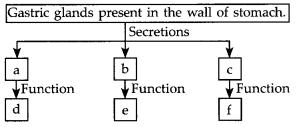
Answer: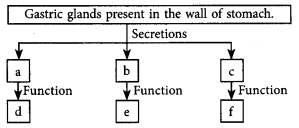
a – Hydrochloric acid (HCl)
b – Protein digesting enzyme pepsin
c – Mucus
d – HCl makes medium acidic for the activation of an enzyme pepsin.
e – Pepsin acts in acidic medium which breaks down proteins into peptones.
f – Mucus protects the inner lining of stomach from corroding action of HCl.
Question 6.
(a) State the role played by the following in the process of digestion :
(i) Enzyme trypsin
(ii) Enzyme lipase-
(b) List two functions of finger-like projections present in the small intestine. (2020)
Answer:
(a) (i) Enzyme trypsin : This enzyme is produced by the pancreas in an inactive form called trypsinogen. Trypsin converts remaining proteins into peptones and the peptones into peptides and amino acids.
(ii) Enzyme lipase : It is secreted by pancreas and small intestine. Lipase converts fats into fatty acids and glycerol.
(b) Internally, the wall of the small intestine is provided with long finger-like projections called villi. Two functions of villi are :
(i) The villi greatly increase the absorptive surface area of the inner lining of small intestine.
(ii) The large surface area of small intestine helps in rapid absorption of digested food.
Question 7.
Explain the significance of photosynthesis. Writd the balanced chemical equation involved in the process. (Board Term I, 2017)
Answer:
Photosynthesis is important for a number of reasons:
(i) Food : By photosynthesis, green plants synthesise food from simple raw materials like CO2 and H2O. Thus, it sustains life on earth.
(ii) Oxygen : Oxygen released during the process of photosynthesis is needed by animals and humans for respiration. It is also required for respiration of microbes. Oxygen also supports combustion of fuels.
(iii) Fuels : Fossil fuels like coal, oil and natural gas are forms of stored solar energy synthesised millions of years ago through photosynthesis. Balanced chemical equation involved in the process of photosynthesis is given as :
Question 8.
Differentiate between autotrophs and hetero- trophs and give one example of each. (Board Term 1,2017)
Answer:
Differences between autotrophs and hetero- trophs are as follows:
| Autotrophs | Heterotrophs |
| (i) These organisms are able to form organic substances from simple inorganic substances such as CO2 and H2S and water. | They cannot produce organic compounds from inorganic sources and therefore completely rely on consuming other organisms for its food requirement. |
| (ii) They have chlorophyll to trap solar energy. | Chlorophyll is absent, so they cannot trap solar energy. |
| (iii) They can be chemoautotroph and photoautotroph. | They can be saprophytic, parasitic and holozoic in mode of nutrition. |
| (iv) Autotrophs are placed at the bottom of the food chain as producers. | Heterotrophs are placed above autotrophs in the food chain as consumers. |
| (v) Green plants, some bacteria and some protists like Euglena are examples of autotrophs. | Mushrooms, Euglena, cow, goat, etc., are examples of heterotrophs. |
Question 9.
Explain with the help of neat and well labelled diagrams the different steps involved in nutrition in Amoeba. (Board Term I, 2015)
Answer:
The mode of nutrition in Amoeba is holozoic. The process of obtaining food by Amoeba is called phagocytosis.
- Amoeba ingests food by using its finger-like projections called pseudopodia.
- The food is engulfed with a little surrounding water to form a food vacuole inside the Amoeba. The food is digested inside food vacuole by digestive enzymes.
- Food is absorbed directly into the cytoplasm of Amoeba by diffusion.
- Food is used to obtain energy and growth of Amoeba.
- When considerable amount of undigested food collects inside Amoeba then its cell membrane ruptures at any place to throw out this undigested food.
Diagrammatic representation of different stages in the holozoic nutrition (feeding) of Amoeba is as follows:
Question 10.
(a) What is peristaltic movement?
(b) ‘Stomata remain closed in desert plants during daytime’. How do they do photosynthesis? (Board Term I, 2013)
Answer:
(a) The relaxation of gut muscles to move the partially digested food downwards throughout the alimentary canal is called peristaltic movement.
(b) In desert plants, stomata open at night and take in carbon dioxide (CO2). Stomata remain closed during daytime to prevent the loss of water by transpiration. They store the CO2 in their cells until the sun comes out so that they can carry on with photosynthesis during the daytime.
Question 11.
(a) Why is nutrition necessary for the human body?
(b) What causes movement of food inside the alimentary canal?
(c) Why is small intestine in herbivores longer than in carnivores?
(d) What will happen if mucus is not secreted by the gastric glands? (2020)
Answer:
(a) Human body continuously require energy for their life activities like respiration, circulation, excretion, etc. Energy is required even we are sleeping because a number of biological processes keep on occurring. All these processes require energy and this energy is obtained from nutrition. Nutrition is also needed for growth and repair of human body.
(b) The wall of alimentary tract contains muscles which can contract and expand alternately. The contraction and expansion movement of the walls of foodpipe is called peristaltic movement. The peristaltic movement moves the partially digested food in all the digestive organs throughout the alimentary canal.
(c) Herbivores eat plants which is rich in cellulose. Cellulose takes longer time for complete digestion by the enzymes present in symbiotic bacteria. Therefore, they have longer small intestine. Carnivores, feed on flesh which is easier to digest and do not contain cellulose also. Therefore, they have shorter intestine for digestion of food eaten by them.
(d) Gastric glands secrete HCl, mucus, rennin and pepsin enzymes. Mucus protects the inner lining of stomach from the action of HCl and enzymes. In the absence of mucus, there would be erosion of inner lining of stomach leading to acidity and ulcers.
Question 12.
(a) State the form in which the following are stored:
(i) Unused carbohydrates in plants.
(ii) The energy derived from food in humans,
(b) Describe the process of nutrition in Amoeba with the help of diagram. (Board Term I, 2016)
Answer:
(a) (i) Unused carbohydrates in plants are stored in the form of complex sugar known as starch. They are later broken down into simple sugars (glucose) when energy is needed.
(ii) The assimilated food molecules hold energy in their chemical bonds. Their bond energy is released by oxidation in the cell. This energy is trapped by forming bonds between ADP (adenosine diphosphate) and inorganic phosphate (Pi) to synthesise ATP (Adenosine triphosphate) molecules. These bonds are later broken by enzymatic hydrolysis and the energy released is utilised for cellular processes.
(b) Amoeba is a unicellular animal. Amoeba eats tiny (microscopic) plants and animals which float in water. The mode of nutrition in Amoeba is holozoic. The process of obtaining food by Amoeba is called phagocytosis. When a food particle comes close to Amoeba, it ingests the food particle by forming temporary finger-like projections called pseudopodia around it. The food is engulfed with a little surrounding water to form a food vacuole inside the Amoeba. The food is digested inside food vacuole by digestive enzymes and absorbed directly into the cytoplasm of Amoeba cell by diffusion. A part of absorbed food is used to obtain energy and the remaining part is utilised for growth of Amoeba. When considerable amount of undigested food collects inside Amoeba then its cell membrane ruptures at any place to throw out this undigested food. This process is called egestion.
Refer to answer 9 for figure.
Question 13.
Anaerobic process
(a) takes place in yeast during fermentation
(b) takes place in the presence of oxygen
(c) produces only energy in the muscles of human beings
(d) produces ethanol, oxygen and energy. (2020)
Answer:
(a) takes place in yeast during fermentation
Question 14.
Diffusion is insufficient to meet the oxygen requirement of multicellular organisms like human. State reason. (Board Term 1,2017)
Answer:
Due to higher metabolic rate and the volume of human body is so large that oxygen cannot diffuse into all cells of the body quickly as oxygen will have to travel large distances to reach each and every cell. So diffusion is insufficient to meet the oxygen demand of multicellular organisms.
Question 15.
Write two different ways in which glucose is oxidised to provide energy in human body. Write the products formed in each case. (Delhi 2019)
Answer:
The two different ways by which glucose is oxidised to provide energy in human body are:
(i) Aerobic respiration : The end products in aerobic respiration are carbon dioxide, water and energy.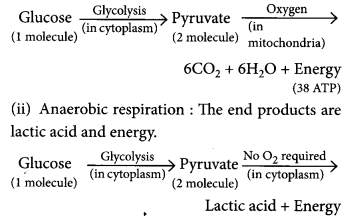
Question 16.
(a) In the process of respiration, state the function of alveoli.
(b) Rate of breathing in aquatic organisms is much faster than that in terrestrial organisms. Give reasons.
(c) Complete the following pathway showing the breakdown of glucose.
Answer:
(a) Functions of alveoli are :
(i) They increase the surface area for exchange of gases.
(ii) The thin walls of alveoli facilitate rapid exchange of oxygen and carbon dioxide between alveolar air and blood.
(b) Aquatic animals like fishes obtain oxygen from water present in the dissolved form through their gills. The amount of dissolved oxygen is quite small as compared to the amount of oxygen in the air. Therefore, to obtain required oxygen from water, aquatic animals have to breathe much faster than the terrestrial organisms.
Question 17.
Write three points of difference between breathing and respiration. (Board Term I, 2016)
Answer:
Differences between breathing and respiration are as follows:
| Breathing | Respiration |
| (i) It is a physical process. It involves inhalation of fresh air and exhalation of foul air. | It is a biochemical process. It involves exchange of respiratory gases and also oxidation of food. |
| (ii) It is an extracellular process. | It is both an extracellular as well as intracellular process. |
| (iii) It does not involve enzyme action rather two types of muscles are involved in this process. | It involves a number of enzymes required for oxidation of food. |
| (iv) It does not release energy, infact it consumes energy. | It releases energy. |
| (v) It is confined to certain organs only. | It occurs in all the cells of the body. |
Question 18.
Draw a flow chart to show the breakdown of glucose by various pathways. (Board Term I, 2016)
Answer:
Breakdown of glucose by various pathways:
Question 19.
Write three points of difference between respiration in plants and respiration in animals. (Board Term I, 2014)
Answer:
Differences between respiration in plants and animals are as follows:
| Plant respiration | Animal respiration |
| (i) All parts of plants, like roots, stem and leaves, perform respiration individually. | Animal performs respiration as a single unit. |
| (ii) There is little transport of respiratory gases from one part to the other during respiration. | Respiratory gases are usually transported over long distance inside an animal during respiration. |
| (iii) Respiration occurs at a very slow rate. | It is a fast process in animals. |
| (iv) There is no special gas transport system. | Gases are transported by specialised blood vascular system. |
| (v) Respiratory organ in plants are generally stomata in leaves, lenticels in stem and general surface of roots. | Respiratory organ in animals are generally lungs and gills. |
Question 20.
(a) Why is there a difference in the rate of breathing between aquatic organisms and terrestrial organisms? Explain
(b) Draw a diagram of human respiratory system and label – pharynx, trachea, lungs, diaphragm and alveolar sac on it. (2020)
Answer:
(a) Terrestrial organisms inspire atmospheric oxygen, while aquatic organisms thrive on the dissolved oxygen present in water. Air contains about 21% of oxygen while water has less than 1% oxygen in dissolved state. Oxygen diffuses through water at a much slower rate as compared to air. A terrestrial organism has the advantage of utilising greater amount of oxygen at a faster rate with lesser effort whereas, aquatic organisms have to put more effort to obtain the same amount of oxygen, therefore breathing in aquatic organisms is much faster than the terrestrial organisms.
(b) The labelled diagram of human respiratory system is a follows :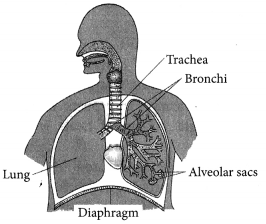
Question 21.
(a) State reasons for the following:
(i) Herbivores need a longer small intestine while carnivores have shorter small intestine.
(ii) The lungs are designed in human beings to maximise the area for exchange of gases.
(b) The rate of breathing in aquatic organisms’is much faster than that seen in terrestrial organisms. (Board Term 1,2016)
Answer:
(a) (i) Herbivores need a longer small intestine than that of carnivores because their diet is mostly grass and plants, that contains more fibres and cellulose which are hard to digest. Longer small intestine also hosts many small bacteria that process and break down cellulose into glucose which is a source of energy. Carnivores diet is not rich in cellulose so, they do not need to harbour bacteria for cellulose digestion.
(ii) Human lungs have a highly branched network of respiratory tubes. A primary bronchus divides into secondary bronchus, which in turn forms tertiary bronchus. Tertiary bronchus divides repeatedly into bronchioles which finally terminate into alveoli. Alveoli are small, rounded polyhedral pouches which are extremely thin- walled and possess a network of capillaries, for the exchange of gases. Due to vast surface area of alveoli, exchange of gases becomes a fast and effective process. Oxygen diffuses from alveoli into pulmonary blood capillaries and CO2 diffuses out from capillaries into alveoli.
(b) Refer to answer 20(a).
Question 22.
Draw a flow chart showing the three different pathways involved in the breakdown of glucose in different organisms. Name the respiratory pigment present in human beings. State the function of rings of cartilage present in our throat. (Board Term I, 2015)
Answer:
Refer to answer 18.
Respiratory pigment present in human beings is haemoglobin.
Rings of cartilage are C in shape, stacked one on top of the other. These cartilaginous rings prevent the trachea from collapsing and blocking the airway.
Question 23.
(a) Draw a diagram of human respiratory system and label: Trachea, Bronchi and Diaphragm.
(b) Give reasons for the following:
(i) Lungs always contain residual volume.
(ii) Nostrils are lined with mucus. (Board Term I, 2013)
Answer:
(a) Refer to answer 20(b).
(b) (i) Lungs always contain residual volume so that during the breathing cycle, when air is inhaled and exhaled, there must be sufficient time for oxygen to be absorbed and for the carbon dioxide to be released. It is also important as it prevents the lungs from collapsing.
(ii) Mucus and hair present in nostrils help in filtration of inhaled air. It traps harmful substances and germs present in air.
Question 24.
Which one of the following statements is correct about the human circulatory system?
(a) Blood transports only oxygen and not carbon dioxide.
(b) Human heart has five chambers.
(c) Valves ensure that the blood does not flow backwards.
(d) Both oxygen – rich and oxygen – deficient blood gets mixed in the heart. (2020)
Answer:
(c) Valves ensure that the blood does not flow backwards.
Question 25.
Name the vein which brings blood to left atrium from lungs. (Board Term I, 2017)
Answer:
Pulmonary vein carries oxygenated blood from lungs to left atrium of heart.
Question 26.
Define translocation in reference to plants. (Board Term I, 2016)
Answer:
The transport of food prepared in the leaves, by the process of photosynthesis, to various parts (roots, stem, branches, etc.) of the plant is called translocation.
Question 27.
Write three types of blood vessels. Give one important feature of each. (Delhi 2019)
Answer:
The three types of blood vessels in human body are: (i) arteries, (ii) veins and (iii) capillaries.
(i) Arteries are the blood vessels which carry blood from heart to various parts of the body. The walls of arteries are thick, elastic and muscular that enables them to dilate but not rupture when the heart contracts and forces blood into them.
(ii) Veins are thin walled blood vessels which bring blood from the body back to the heart. They are larger and hold more blood than the arteries. The lumen of veins are provided with valves to prevent the backflow of blood.
(iii) Capillaries are thin walled and extremely narrow blood vessels which occur at the terminals of artery and vein. The wall of capillaries are permeable to water and dissolved substances so that the exchange of materials between the blood and body cells can take place.
Question 28.
(a) Write two water conducting tissues present in plants. How does water enter continuously into the root xylem?
(b) Explain why plants have low energy needs as compared to animals. (AI 2019)
Answer:
(a) Xylem tracheids and vessels are two water conducting tissues present in plants that help in rapid movement of water. In xylem tissue, vessels and tracheids of the roots, stems and leaves are interconnected to form a continuous system of water conducting channels reaching all parts of the plant.
Minerals and water needed by the plants are absorbed by root hairs from the soil by the process of osmosis and take in minerals by the process of diffusion. Thus, a difference in concentration of ions is created between the roots and the soil which enables the water to enter into roots to compensate the difference in concentration. The water, alongwith dissolved minerals from root hairs, passes into xylem vessels through cells of the cortex, endodermis and pericycle and then ascent of sap (i.e., upward movement of water and mineral salts from roots to the aerial parts of the plant against the gravitational force) takes place from xylem of the roots to the xylem of stem and leaves through vessels and tracheids. Evaporation of water molecules from the cells of leaves creates a suction pressure which pulls the water from xylem cells.
(b) Plants are autotrophic and do not have to move from one place to another in search of their food. Movements in a plant are usually at the cellular level and hence they required less amount of energy. Whereas animals are heterotrophic and locomote in search of food and other activities, hence require higher amount of energy than of plants.
Question 29.
Explain how the translocation of materials in phloem tissue in plants is achieved by utilising energy. (Board Term I, 2017)
Answer:
The phloem cells transport the soluble food materials to all parts of plant. The transport of food from leaves to different parts of plant is termed as translocation. Components of phloem are sieve tubes, companion cells, phloem parenchyma and phloem fibres. The food is manufactured in the mesophyll cells (or photosynthetic cells) of a leaf. The manufactured food enters into sieve tubes of the phloem and is transported as a dilute aqueous solution either in upward or downward direction. Food is transported to all non-green parts of the plant for their growth and metabolic activities. Besides food molecules, phloem also transports amino acids, hormones synthesised in the shoot tips and root tips and other metabolites.
In this process, glucose is transferred to phloem tissue using energy from ATP. This increases the osmotic pressure of the tissue causing the water to move into it (endosmosis). Soluble material is then transferred from phloem tissue to other tissues which have less pressure than in the phloem. Thus, according to plants requirement, the material is translocated from higher osmotic pressure areas to lower osmotic pressure areas.
Question 30.
What do the following transport?
(i) Xylem
(ii) Phloem
(iii) Pulmonary vein
(iv) Vena cava
(v) Pulmonary artery
(vi) Aorta (Board Term I, 2014)
Answer:
(i) Xylem is a specialised plant conducting tissue that transports water and minerals from roots to all aerial parts of plants which occurs against gravitational force with the help of ascent of sap.
(ii) Phloem transports food that is prepared in the leaves, through photosynthesis, to various parts of plant. This process is called translocation. Phloem also transports amino acids, hormones synthesised in the shoot tips and root tips and other metabolites.
(iii) Pulmonary vein present in human circulatory system brings oxygenated blood from lungs to the left atrium of heart.
(iv) Vena cava transport deoxygenated blood collected by all veins of body except pulmonary vein and pass it to the right atrium of heart.
(v) Pulmonary artery transports deoxygenated blood from right atrium of heart to lungs for oxygenation.
(vi) Aorta transports oxygenated blood from left atrium to systemic arteries which further take the blood to various body parts and organs.
Question 31.
Explain giving any three reasons the significance of transpiration in plants. (Board Term I, 2014)
Answer:
Significance of transpiration in plants:
(i) The absorbed water is transported from roots to leaves through xylem vessels which is greatly influenced by transpiration pull.
(ii) The water stream moving upwards carries dissolved minerals with it. Transpiration also helps in distributing these minerals throughout the plant.
(iii) The evaporation of water during transpiration provide cooling effect to the leaves.
Question 32.
List in tabular form three differences between arteries and veins. (Board Term I, 2013)
Answer:
Differences between arteries and veins are as follows:
| Arteries | Veins |
| (i) Arteries are the blood vessels which carry blood away from the heart for distribution to the body. | Veins are blood vessels which bring blood from the body back to the heart. |
| (ii) Arteriei walls are thick and valves are absent. | Their walls are thin and valves are present to prevent back flow of blood. |
| (iii) Blood passing through narrow lumen of arteries is mostly oxygenated and has a considerable pressure. | The blood passing through wide lumen of veins is deoxygenated (except in pulmonary veins) and has low pressure. |
| (iv) More elastic and placed deeply. | Less elastic and superficially placed. |
Question 33.
Give reasons:
(a) Ventricles have thicker muscular walls than atria.
(b) Transport system in plants is slow.
(c) Circulation of blood in aquatic vertebrates differs from that in terrestrial vertebrates.
(d) During the daytime, water and minerals travel faster through xylem as compared to the night.
(e) Veins have valves whereas arteries do not. (2020)
Answer:
(a) Since ventricles have to pump blood into various organs with high pressure, they have thicker walls than atria.
(b) Transport system in plants is less elaborate than in animals, as plants are less active, so their cells do not need to be supplied with materials so quickly.
(c) The aquatic vertebrates like fish have gills to oxygenate blood. The flow of blood in a fish is single circulation because the blood passes through the heart only once in one complete cycle of body. The terrestrial vertebrates like birds and humans have double circulation as the blood travels heart twice in one complete cycle of blood and they have lungs for oxygenation of blood.
(d) It is because during daytime rate of transpiration is higher.
(e) The lumen of veins have valves, which allow the blood in them to flow in only one direction. Thus prevent back flow of blood.
Question 34.
(a) “Blood circulation in fishes is different from the blood circulation in human beings”. Justify the statement.
(b) Describe “blood circulation” in human beings. (2020)
Answer:
(a) Fishes have only two chambers in their heart, the blood is pumped to the gills to get oxygenated blood and from there it passes directly to rest of the body. Thus, the blood goes only once through the heart during one cycle of passage through the body. This type of circulation is termed as single circulation.
In human beings, during circulation blood travels twice through the heart in one complete cycle of the body and is called double circulation. The pathway of blood from the heart to the lungs and back to the heart is called pulmonary circulation and the pathway of blood from the heart to the rest of the body and back to heart is called systemic circulation.
(b) Deoxygenated blood from the body tissues is poured into right atrium. Contraction of heart forces it into right ventricle. From right ventricle, deoxygenated blood flows to the lungs through pulmonary artery. Oxygenated blood from lungs is returned into left atrium and then into left ventricle. The left ventricle forces the oxygenated blood to the whole body. Thus, for making one complete round or circulation circuit around all body parts, the blood passes through the heart twice. This is known as double circulation of blood.
Question 35.
(a) Mention any two components of blood.
(b) Trace the movement of oxygenated blood in the body.
(c) Write the function of valves present in between atria and ventricles.
(d) Write one structural difference between the composition of artery and veins. (2018)
Answer:
(a) Two components of blood are blood plasma and blood corpuscles.
(b) Deoxygenated blood gets oxygenated in the lungs, from there it moves to heart and pumped to different parts of the body. Its path can be traced out as
Lungs → Pulmonary veins → Left atrium of heart → Aorta → Arteries → Body parts
(c) When blood is pumped, valves prevent back flow of blood between ventricles and atria. They open and allow the right amount of blood to flow from one chamber to the other.
(d) Structural difference between veins and arteries is as follows:
Veins:
Veins have thin, less elastic and less muscular walls. They have valves to prevent back flow of blood.
Arteries:
Arteries have thick, elastic and muscular walls with no valves.
Question 36.
Draw a diagram of human excretory system and label kidneys, ureters on it. (Board Term I, 2017)
Answer:
Diagram of human excretory system is as follows: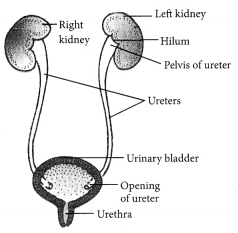
Question 37.
Draw a neat diagram of excretory system of human beings and label on it:
(i) Left kidney
(ii) Urinary bladder. (Board Term I, 2016)
Answer:
Refer to answer 36.
Question 38.
Describe the structure and function of nephron with the help of diagram. (Board Term I, 2014)
Answer:
Structure of nephron is as follows: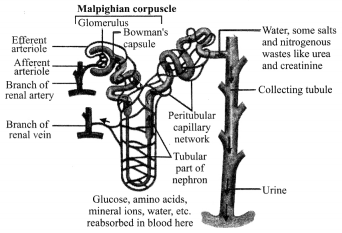
The function of nephron is filtration of blood and elimination of waste material from it. Blood is filtered from the blood capillaries into Bowmans capsule and pour the filtrate into the renal tubule. In this part, large amount of water and useful substances like glucose, amino acid, minerals ions, etc., are reabsorbed. Nitrogenous waste along with little amount of water is sent to the urinary bladder, which later expels the urine to the outside through urethra.
Question 39.
(a) Name four types of metabolic wastes produced by humans.
(b) Name any two human excretory organs other than kidney. (Board Term I, 2013)
Answer:
(a) Four types of metabolic wastes produced by human are urea, carbon dioxide, water and salts.
(b) Two human excretory organs other than kidneys are:
(i) Lungs : They help to eliminate carbon dioxide.
(ii) Liver : It is an excretory organ as it converts harmful amino acids to harmless urea and haemoglobin of worn out RBCs to bilirubin and biliverdin that can be excreted out of the body.
Question 40.
(a) Name the organs that form the excretory system in human beings.
(b) Describe in brief how urine is produced in human body. (2020)
Answer:
(a) Excretory system (Urinary system) in human beings consists of a pair of kidneys, a pair of ureters, urinary bladder and urethra.
(b) In the kidney, the wastes are converted to urine by three processes :
(i) Ultrafiltration : In it, large amount of water along with certain harmful substances like urea, uric acid, K+, ammonium salts, creatinine, etc., and certain useful substances like glucose, amino acids, Na+, etc., pass through glomerular capillaries and glomerular membrane into cavity of Bowman’s capsule of nephrons under pressure. The filtrate so formed is called nephric filtrate which is moved towards ureter.
(ii) Selective reabsorption : In it, large amount of water and sodium, whole of glucose and amino acids and small amount of urea are passed back from nephric filtrate into blood capillaries. It occurs either by back diffusion (i.e., water and urea) or active transport (i.e., Na+, glucose and amino acids). It generally occurs in PCT (Proximal convoluted tubule) of nephrons.
(iii) Tubular secretion : In this, certain harmful chemicals like uric acid, creatinine, K+, etc., are passed from blood capillaries surrounding the nephron into nephric filtrate by active transport. It generally occurs in DCT (Distal convoluted tubule) of nephrons. Now, the fluid is termed as urine and is excreted out of the excretory organs.
Question 41.
(a) Define excretion.
(b) Name the basic filtration unit present in the kidney.
(c) Draw excretory system in human beings and label the following organs of excretory system which perform following functions:
(i) form urine
(ii) is a long tube which collects urine from kidney
(iii) store urine until it is passed out. (2018)
Answer:
(a) The biological process involved in the removal of wastes, produced during various metabolic activities in the body from the body of an organism is called excretion. The wastes are non-gaseous nitrogenous wastes like ammonia, urea, uric acid, etc., along with excess of water, salts and pigments.
(b) Basic filtration unit present in kidney is nephron.
(c) Refer to answer 36.
(i) Kidney
(ii) Ureter
(iii) Urinary bladder
Question 42.
(a) Draw a neat diagram of the human excretory system and label following parts:
(i) Urethra
(ii) Kidney
(iii) Ureter
(iv) Urinary bladder
(b) What are nephrons ? How is a nephron involved in the filtration of blood and formation of urine? (Board Term I, 2015)
Answer:
(a) Refer to answer 36 for figure.
(b) Nephrons are the functional unit of kidney. Each kidney has about one million nephrons. Each nephron consists of a cup-shaped structure called Bowman’s capsule containing a bunch of capillaries called glomerulus. Bowman’s capsule leads into tubular structure which ultimately joins the transverse collecting tubule.
Filtration of blood and formation of urine in nephron involves the following steps:
(i) The blood along with waste and excess water is brought to kidney by renal arteries. Blood is filtered from the blood capillaries into Bowmans capsule.
(ii) As the nephric filtrate passes through the tubular part of nephron, useful substances like glucose, amino acid, mineral ions, water, etc., are reabsorbed by blood capillaries surrounding the nephron.
(iii) Tubular secretion occurs mainly in the renal tubule and the collecting duct of the nephron where additional wastes are excreted from the blood stream into the filtrate.
(iv) The fluid that flows through collecting tubule is urine which consists of water, urea, uric acid, mineral ions like sodium, potassium, chloride, phosphates, etc.
Question 43.
(a) Draw a well-labelled diagram of structural and functional unit of kidney.
(b) Explain the mechanism of the urine formation. (Board Term I, 2013)
Answer:
(a) Structural and functional unit of kidney is nephron. Its structure is as follows: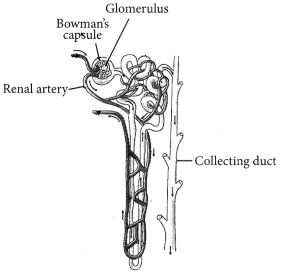
(b) Main function of nephron is to form urine. The three main processes involved in the urine formation are:
(i) Ultrafiltration: It is the filtration of body fluids and solutes from the blood, out of the glomerular capillaries into the Bowmans capsule due to the pressure of the glomerulus. All substances from the blood are filtered out except the large protein molecules and blood corpuscles. This fluid in the glomerular capsule is called glomerular filtrate. It consists of water, urea, salts, glucose and other plasma solutes.
(ii) Selective reabsorption : Glomerular filtrate contains a lot of useful materials like water, glucose and salts such as sodium. These substances are reabsorbed by blood capillaries surrounding the nephron from the renal tubule at various levels and to various extents.
(iii) Tubular secretion : This occurs mainly in the renal tubule and the collecting duct of the nephron. It is a process performed by the cells of the cuboidal epithelium lining the tubules which excrete additional wastes from the blood stream into the filtrate by active transport. In this process substances like potassium, hydrogen, creatinine and certain drugs like phenol, penicillin, etc., are directly excreted by the tubular cells from the blood. The fluid which now flows through collecting tubule is urine which consists of water, urea, uric acid, mineral ions like sodium, potassium, chloride, phosphates, etc.
Life Process Class 10 Science Notes
Nutrition in Plants and Animals – Life Processes Class 10 Notes
- Nutrition: The process by which an organism takes food and utilizes it, is called nutrition.
- Need for Nutrition: Organisms need the energy to perform various activities. The energy is supplied by the nutrients. Organisms need various raw materials for growth and repair. These raw materials are provided by nutrients.
- Nutrients: Materials which provide nutrition to organisms are called nutrients. Carbohydrates, proteins and fats are the main nutrients and are called macronutrients. Minerals and vitamins are required in small amounts and hence are called micronutrients.
- Modes of Nutrition
1. Autotrophic Nutrition.
2. Heterotrophic Nutrition.
Autotrophic Nutrition – Life Processes Class 10 Notes
The mode of nutrition in which an organism prepares its own food is called autotrophic nutrition. Green plants and blue-green algae follow the autotrophic mode of nutrition.
- The organisms which carry out autotrophic nutrition are called autotrophs (green plants).

- Autotrophic nutrition is fulfilled by the process, by which autotrophs intake CO2 and H2O, and convert these into carbohydrates in the presence of chlorophyll, sunlight is called photosynthesis.
- Equation
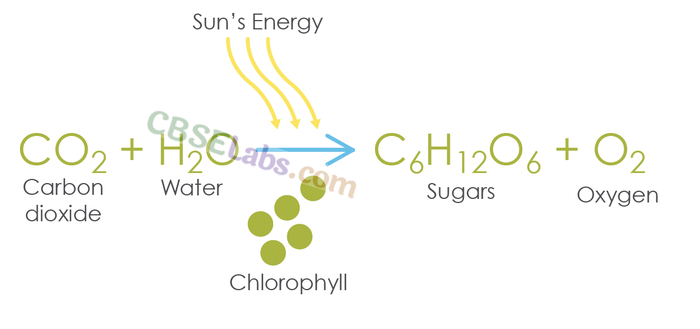
Nutrition in Plants: Green plants prepare their own food. They make food in the presence of sunlight. Sunlight provides energy’, carbon dioxide and water are the raw materials and chloroplast is the site where food is made.
What is Photosynthesis in biology class 10?
Photosynthesis: The process by which green plants prepare food is called photosynthesis.
- During this process, the solar energy is converted into chemical energy and carbohydrates are formed.
- Green leaves are the main site of photosynthesis.
- The green portion of the plant contains a pigment chloroplast, chlorophyll (green pigment).
- The whole process of photosynthesis can be shown by the following equation:

Raw Materials for Photosynthesis:
- Sunlight
- Chlorophyll: Sunlight absorbed by chloroplast
- CO2: Enters through stomata, and oxygen (O2) is released as a byproduct through stomata on the leaf.
- Water: Water + dissolved minerals like nitrogen, phosphorous etc., are taken up by the roots from the soil.
How do raw materials for photosynthesis become available to the plant?
- Water comes from the soil, through the xylem tissue in roots and stems.
- Carbon dioxide comes in the leaves through stomata.
Site of Photosynthesis: Chloroplast in the leaf. Chloroplast contains chlorophyll (green pigment)
Main Events of Photosynthesis:
- Absorption of light energy by chlorophyll.
- Conversion of light energy into chemical energy + splitting (breaking) of water into hydrogen and oxygen.
- Reduction of CO2 to carbohydrates.
- Sunlight activates chlorophyll, which leads to splitting of the water molecule.
- The hydrogen, released by the splitting of a water molecule is utilized for the reduction of carbon dioxide to produce carbohydrates.
- Oxygen is the by-product of photosynthesis.
- Carbohydrate is subsequently converted into starch and is stored in leaves and other storage parts.
- The splitting of water molecules is a part of the light reaction.
Other steps are part of the dark reaction during photosynthesis.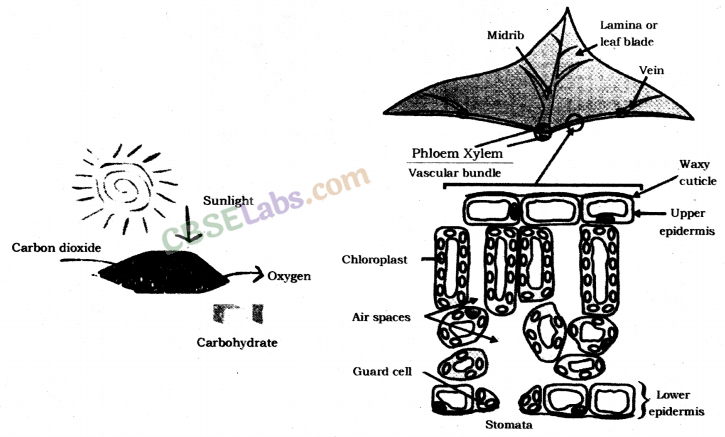
Stomata – Life Processes Class 10 Notes
- Stomata: These are tiny pores present in the epidermis of leaf or stem through which gaseous exchange and transpiration occur.
Functions of stomata
- Exchange of gases, O2 and CO2.
- Loses a large amount of water (water vapour) during transpiration.
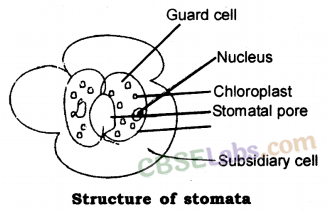
Opening and closing of stomatal pores:
- The opening and closing of stomatal pores are controlled by the turgidity of guard cells.
- When guard cells uptake water from surrounding cells, they swell to become a turgid body, which enlarges the pore in between (Stomatal Opening).
- While, when water is released, they become flaccid shrinking to close the pore (Stomatal Closing).
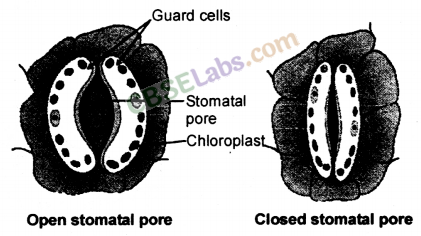
Significance of Photosynthesis:
- Photosynthesis is the main way through which solar energy is made available for different living beings.
- Green plants are the main producers of food in the ecosystem. All other organisms directly or indirectly depend on green plants for food.
- The process of photosynthesis also helps in maintaining the balance of carbon dioxide and oxygen in the air.
Heterotrophic Nutrition – Life Processes Class 10 Notes
The mode of nutrition in which an organism takes food from another organism is called heterotrophic nutrition. Organisms, other than green plants and blue-green algae follow the heterotrophic mode of nutrition. Heterotrophic nutrition can be further divided into three types, viz. saprophytic nutrition, holozoic nutrition, and parasitic.
- Saprophytic Nutrition: In saprophytic nutrition, the organism secretes the digestive juices on the food. The food is digested while it is still to be ingested. The digested food is then ingested by the organism. All the decomposers follow saprophytic nutrition. Some insects, like houseflies, also follow this mode of nutrition.
- Holozoic Nutrition: In holozoic nutrition, the digestion happens inside the body of the organism. i.e., after the food is ingested. Most of the animals follow this mode of nutrition.
- Parasitic Nutrition: The organism which lives inside or outside another organism (host) and derives nutrition from it is known as parasites and this type of mode of nutrition is called parasitic nutrition. For example Cuscuta, tick etc.
Nutrition in Amoeba
- Amoeba is a unicellular animal which follows the holozoic mode of nutrition.
- In holozoic nutrition, the digestion of food follows after the ingestion of food. Thus, digestion takes place inside the body of the organism.
- Holozoic nutrition happens in five steps, viz. ingestion, digestion, absorption, assimilation and egestion.
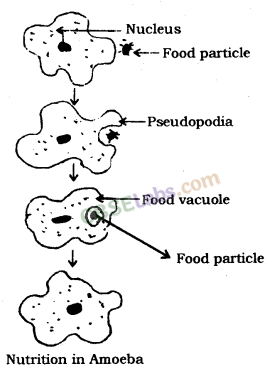
Steps of Holozoic Nutrition:
- Ingestion: The process of taking in the food is called ingestion.
- Digestion: The process of breaking complex food substances into simple molecules is called digestion. Simple molecules, thus obtained, can be absorbed by the body.
- Absorption: The process of absorption of digested food is called absorption.
- Assimilation: The process of utilization of digested food, for energy and for growth and repair is called assimilation.
- Egestion: The process of removing undigested food from the body is called egestion.
Amoeba is a unicellular animal which follows the holozoic mode of nutrition. The cell membrane of amoeba keeps on protruding into pseudopodia. Amoeba surrounds a food particle with pseudopodia and makes a food vacuole. The food vacuole contains food particle and water. Digestive enzymes are secreted in the food vacuole and digestion takes place. After that, digested food is absorbed from the food vacuole. Finally, the food vacuole moves near the cell membrane and undigested food is expelled out.
Nutrition in Human Beings – Life Processes Class 10 Notes
Human beings are complex animals, which have a complex digestive system. The human digestive system is composed of an alimentary canal and some accessory glands. The alimentary canal is divided into several parts, like oesophagus, stomach, small intestine, large intestine, rectum and anus. Salivary gland, liver and pancreas are the accessory glands which lie outside the alimentary canal.
Structure of the Human Digestive System:
The human digestive system comprises of the alimentary canal and associated digestive glands.
- Alimentary Canal: It comprises of mouth, oesophagus, stomach, small intestine and large intestine.
- Associated Glands: Main associated glands are
- Salivary gland
- Gastric Glands
- Liver
- Pancreas
Mouth or Buccal Cavity:
- The mouth has teeth and tongue. Salivary glands are also present in the mouth.
- The tongue has gustatory receptors which perceive the sense of taste.
- The tongue helps in turning over the food so that saliva can be properly mixed in it.
- Teeth help in breaking down the food into smaller particles so that, swallowing of food becomes easier.
- There are four types of teeth in human beings. The incisor teeth are used for cutting the food.
- The canine teeth are used for tearing the food and for cracking hard substances.
- The premolars are used for the coarse grinding of food. The molars are used for fine grinding of food.
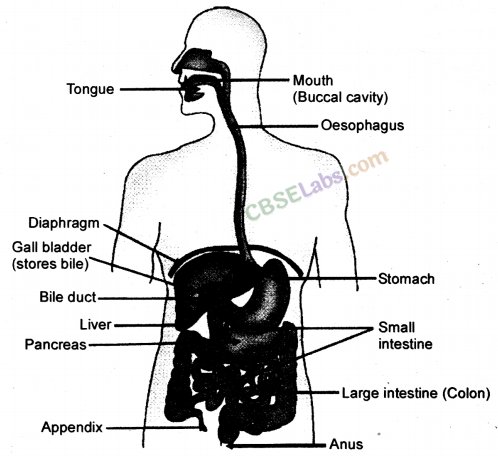
Salivary glands secrete saliva: Saliva makes the food slippery which makes it easy to swallow the food. Saliva also contains the enzyme salivary amylase or ptyalin. Salivary amylase digests starch and converts it into sucrose, (maltose).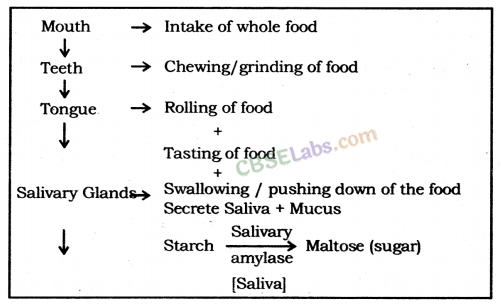
Oesophagus: Taking food from mouth to stomach by Peristaltic movement.
Peristaltic movement: Rhythmic contraction of muscles of the lining of the alimentary canal to push the food forward.
Stomach
- Stomach is a bag-like organ. Highly muscular walls of the stomach help in churning the food.
- The walls of the stomach secrete hydrochloric acid. Hydrochloric acid kills the germs which may be present in food.
- Moreover, it makes the medium inside the stomach as acidic. The acidic medium is necessary for gastric enzymes to work.
- The enzyme pepsin, secreted in the stomach, does partial digestion of protein.
- The mucus, secreted by the walls of the stomach saves the inner lining of the stomach from getting damaged from hydrochloric acid.
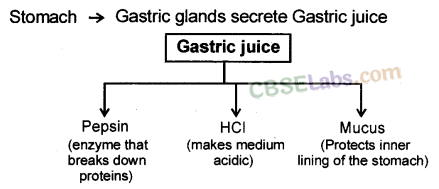
Small Intestine: It is a highly coiled tube-like structure. The small intestine is longer than the large intestine but its lumen is smaller than that of the large intestine. The small intestine is divided into three parts, like duodenum, jejunum and ileum.
Liver: Liver is the largest organ in the human body. The liver manufactures bile, which gets stored in the gall bladder. From the gall bladder, bile is released as and when required.
Pancreas: Pancreas is situated below the stomach. It secretes pancreatic juice which contains many digestive enzymes.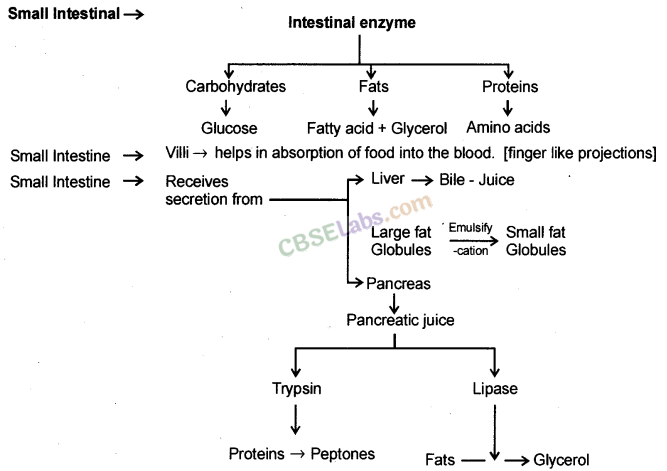
Bile and pancreatic juice go to the duodenum through a hepatopancreatic duct. Bile breaks down fat into smaller particles. This process is called emulsification of fat. After that, the enzyme lipase digests fat into fatty acids and glycerol. Trypsin and chymotrypsin are enzymes which digest protein into amino acids. Complex carbohydrates are digested into glucose. The major part of digestion takes place in the duodenum.
No digestion takes place in the jejunum: The inner wall in the ileum is projected into numerous finger-like structures, called villi. Villi increase the surface area inside the ileum so that optimum absorption can take place. Moreover, villi also reduce the lumen of the ileum so that food can stay for a longer duration in it, for optimum absorption. Digested food is absorbed by villi.
Large Intestine:
- Large intestine is smaller than the small intestine.
- Undigested food goes into the large intestine.
- Some water and salt are absorbed by the walls of the large intestine. After that, the undigested food goes to the rectum, from where it is expelled out through the anus.
- Large Intestine bbsorb excess of water. The rest of the material is removed from the body via the anus. (Egestion).
Respiration – Life Processes Class 10 Notes
Types of respiration, aerobic and anaerobic respiration, human respiratory system, respiration in plants.
Respiration: The process by which a living being utilises the food to get energy, is called respiration. Respiration is an oxidation reaction in which carbohydrate is oxidized to produce energy. Mitochondria is the site of respiration and the energy released is stored in the form of ATP (adenosine triphosphate). ATP is stored in mitochondria and is released as per need.
Steps of respiration:
- Breaking down of glucose into pyruvate: This step happens in the cytoplasm. Glucose molecule is broken down into pyruvic acid. Glucose molecule is composed of 6 carbon atoms, while pyruvic acid is composed of 3 carbon atoms.
- Fate of Pyruvic Acid: Further breaking down of pyruvic acid takes place in mitochondria and the molecules formed depend on the type of respiration in a particular organism. Respiration is of two types, viz. aerobic respiration and anaerobic respiration.
- Respiration involves
- Gaseous exchange: Intake of oxygen from the atmosphere and release of CO2 → Breathing.
- Breakdown of simple food in order to release energy inside the cell → Cellular respiration
Types of Respiration – Life Processes Class 10 Notes
- Aerobic respiration: This type of respiration happens in the presence of oxygen. Pyruvic acid is converted into carbon dioxide. Energy is released and water molecule is also formed at the end of this process.
- Anaerobic respiration: This type of respiration happens in the absence of oxygen. Pyruvic acid is either converted into ethyl alcohol or lactic acid. Ethyl alcohol is usually formed in case of anaerobic respiration in microbes, like yeast or bacteria. Lactic acid is formed in some microbes as well as in the muscle cells.
- Glucose (6 carbon molecule) → Pyruvate (3 carbon molecules) + Energy
- Pyruvate (In yeast, lack of O2) → Ethyl alcohol + Carbon dioxide + Energy
- Pyruvate (In muscles, lack of O2) → Lactic Acid + Energy
- Pyruvate (In mitochondria; the presence of O2) → Carbon dioxide + Water + Energy
The equations for the above reactions can be written as follows:

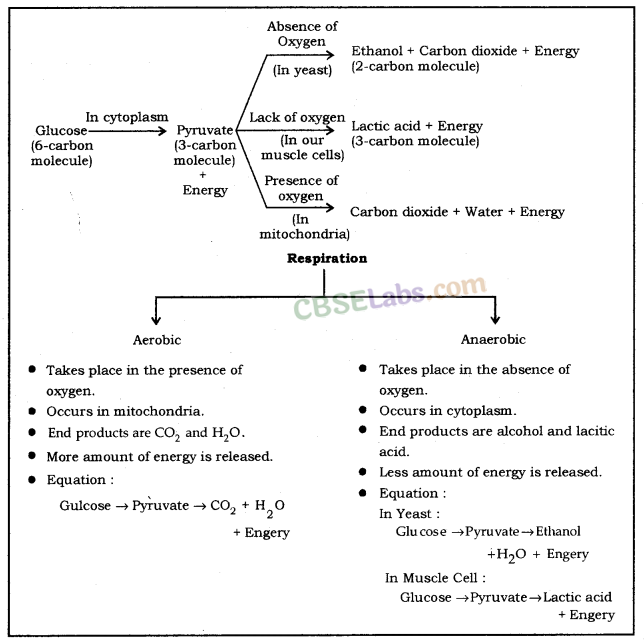
Pain in leg muscles while running:
- When someone runs too fast, he may experience throbbing pain in the leg muscles. This happens because of anaerobic respiration taking place in the muscles.
- During running, the energy demand from the muscle cells increases. This is compensated by anaerobic respiration and lactic acid is formed in the process.
- The deposition of lactic acid causes pain in the leg muscles. The pain subsides after taking rest for some time.
Exchange of gases:
- For aerobic respiration, organisms need a continuous supply of oxygen, and carbon dioxide produced during the process needs to be removed from the body.
- Different organisms use different methods for the intake of oxygen and expulsion of carbon dioxide.
- Diffusion is the method which is utilized by unicellular and some simple organisms for this purpose.
- In plants also, diffusion is utilized for exchange of gases.
- In complex animals, respiratory system does the job of exchange of gases.
- Gills are the respiratory organs for fishes. Fishes take in oxygen which is dissolved in water through gills.
- Since, availability of oxygen is less in the aquatic environment, so the breathing rate of aquatic organisms is faster.
- Insects have a system of spiracles and trachease which is used for taking in oxygen.
- Terrestrial organisms have developed lungs for exchange of gases.
- Availability of oxygen is not a problem in the terrestrial environment so breathing rate is slower as compared to what it is in fishes.
Terrestrial organisms: Use atmospheric oxygen for respiration.
Aquatic organisms: Use dissolve oxygen for respiration.
Human respiratory system – Life Processes Class 10 Notes
The human respiratory system is composed of a pair of lungs. These are attached to a system of tubes which open on the outside through the nostrils.
Following are the main structures in the human respiratory system:
- Nostrils: There are two nostrils which converge to form a nasal passage. The inner lining of the nostrils is lined by hair and remains wet due to mucus secretion. The mucus and the hair help in filtering the dust particles out from inhaled air. Further, air is warmed up when it enters the nasal passage.
- Pharynx: It is a tube-like structure which continues after the nasal passage.
- Larynx: This part comes after the pharynx. This is also called voice box.
- Trachea: This is composed of rings of cartilage. Cartilaginous rings prevent the collapse of trachea in the absence of air.
- Bronchi: A pair of bronchi comes out from the trachea, with one bronchus going to each lung.
- Bronchioles: A bronchus divides into branches and sub-branches inside the lung.
- Alveoli: These are air sacs at the end of bronchioles. The alveolus is composed of a very thin membrane and is the place where blood capillaries open. This is alveolus, where the oxygen mixes with the blood and carbon dioxide exits from the blood. The exchange of gases, in alveoli, takes place due to the pressure differential.
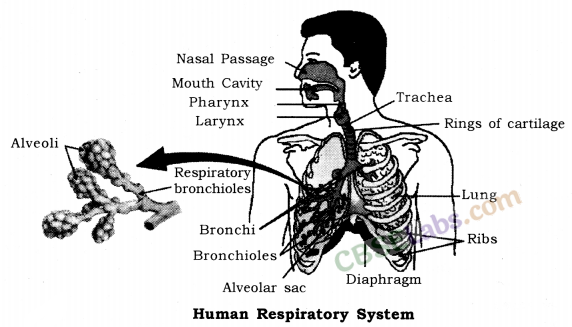
Passage of air through the respiratory system in human beings: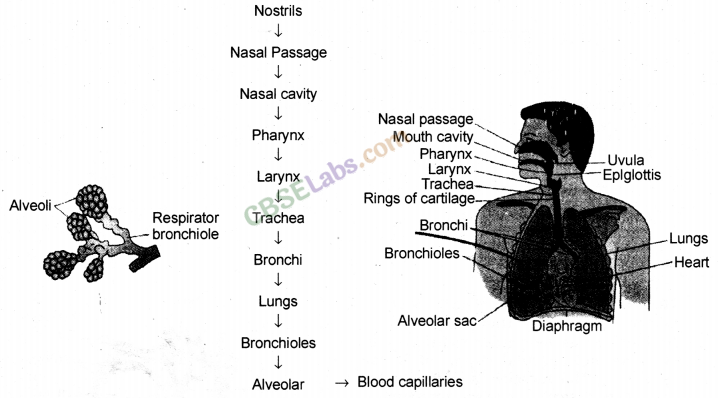
Breathing Mechanism
- The breathing mechanism of lungs is controlled by the diaphragm and the intercostalis muscles.
- The diaphragm is a membrane which separates the thoracic chamber from the abdominal cavity.
- When the diaphragm moves down, the lungs expand and the air is inhaled.
- When the diaphragm moves up, the lungs contract and air are exhaled.
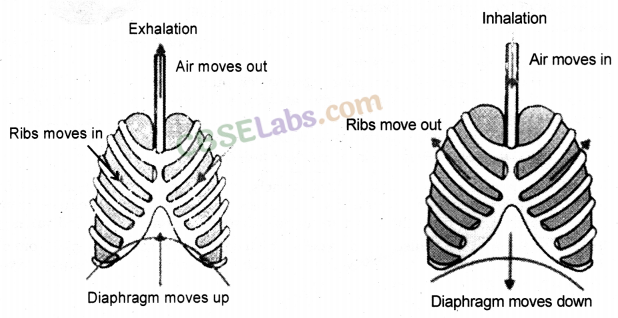
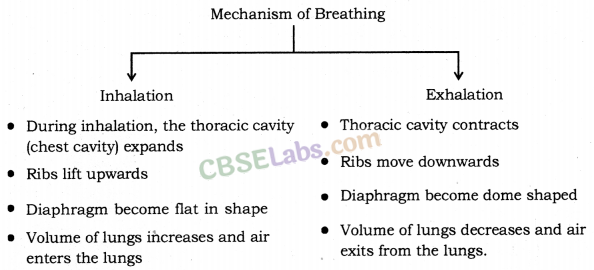
Transportation – Life Processes Class 10 Notes
Circulatory system of human being, transportation in plants. Human beings like other multicellular organism need a regular supply of foods, oxygen etc. This function is performed by a circulatory system or transport system.
Transportation in Human Beings: The circulatory system is responsible for transport of various substances in human beings. It is composed of the heart, arteries, veins and blood capillaries. Blood plays the role of the carrier of substances.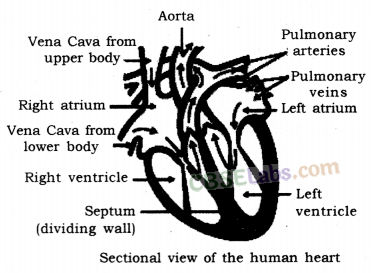
1. Heart: Heart is a muscular organ, which is composed of cardiac muscles.
- It is so small that, it can fit inside an adult’s wrist. The heart is a pumping organ which pumps the blood.
- The human heart is composed of four chambers, viz. right atrium, right ventricle, left ventricle and left atrium.
- Systole: Contraction of cardiac muscles is called systole.
- Diastole: Relaxation of cardiac muscles is called diastole.
2. Arteries:
- These are thick-walled blood vessels which carry oxygenated blood from the heart to different organs.
- Pulmonary arteries are exceptions because they carry deoxygenated blood from the heart to lungs, where oxygenation of blood takes place.
3. Veins:
- These are thin-walled blood vessels which carry deoxygenated blood from different organs to the heart, pulmonary veins are exceptions because they carry oxygenated blood from lungs to the heart.
- Valves are present in veins to prevent back flow of blood.
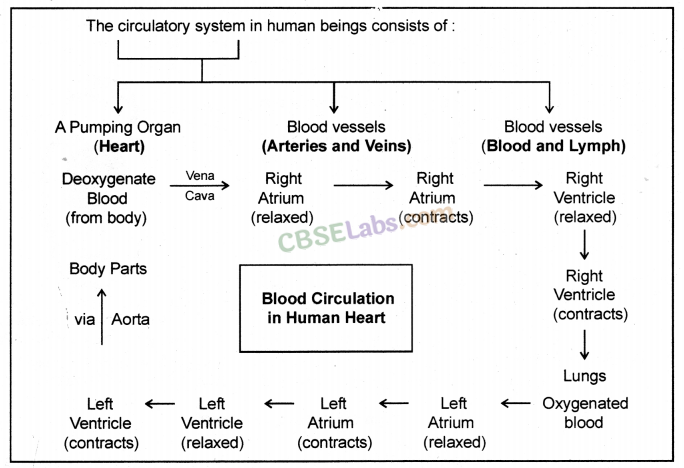
4. Capillaries: These are the blood vessels which have single-celled walls.
Blood: Blood is a connective tissue which plays the role of the carrier for various substances in the body. Blood is composed of 1. Plasma 2. Blood cells 3. Platelets.
- Blood plasma: Blood plasma is a pale coloured liquid which is mostly composed of water. Blood plasma forms the matrix of blood.
- Bloods cells: There are two types of blood cells, viz. Red Blood Cells (RBCs) and White Blood Cells (WBCs).
(a) Red Blood Corpuscles (RBCs): These are of red colour because of the presence of haemoglobin which is a pigment. Haemoglobin readily combines with oxygen and carbon dioxide. The transport of oxygen happens through haemoglobin. Some part of carbon dioxide is also transported through haemoglobin.
(b) White Blood Corpuscles (WBCs): These are of pale white colour. They play important role in the immunity. - Platelets: Platelets are responsible for blood coagulation. Blood coagulation is a defense mechanism which prevents excess loss of blood, in case of an injury.
Lymph:
- Lymph is similar to blood but RBCs are absent in lymph.
- Lymph is formed from the fluid which leaks from blood capillaries and goes to the intercellular space in the tissues. This fluid is collected through lymph vessels and finally return to the blood capillaries.
- Lymph also plays an important role in the immune system.
- Lymph a yellowish fluids escape from the blood capillaries into the intercellular spaces contain less proteins than blood.
- Lymph flows from the tissues to the heart assisting in transportation and destroying germs.
Double circulation: In the human heart, blood passes through the heart twice in one cardiac cycle. This type of circulation is called double circulation. One complete heartbeat in which all the chambers of the heart contract and relax once is called cardiac cycle. The heart beats about 72 times per minute in a normal adult. In one cardiac cycle, the heart pumps out 70 mL blood and thus, about 4900 mL blood in a minute. Double circulation ensures complete segregation of oxygenated and deoxygenated blood which is necessary for optimum energy production in warm-blooded animals.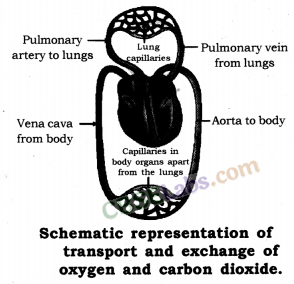
Transportation in plants: Plants have specialized vascular tissues for transportation of substances. There are two types of vascular tissues in plants.
- Xylem: Xylem is responsible for transportation of water and minerals. It is composed of trachids, xylem vessels, xylem parenchyma and xylem fibre. Tracheids and xylem vessels are the conducting elements. The xylem makes a continuous tube in plants which runs from roots to stem and right up to the veins of leaves.
- Carry water and minerals from the leaves to the other part of the plant.
- Phloem: Phloem is responsible for transportation of food. Phloem is composed of sieve tubes, companion cells, phloem parenchyma and bast fibers. Sieve tubes are the conducting elements in phloem.
- Carries product of photosynthesis from roots to other part of the plant.
Transportation in plants
Ascent of sap: The upward movement of water and minerals from roots to different plant parts is called ascent of sap. Many factors are at play in ascent of sap and it takes place in many steps. They are explained as follows :
- Root pressure: The walls of cells of root hairs are very thin. Water from soil enters the root hairs because of osmosis. Root pressure is responsible for movement of water up to the base of the stem.
- Capillary action: A very fine tube is called capillaiy, water, or any liquid, rises in the capillary because of physical forces and this phenomenon is called capillary action. Water, in stem, rises up to some height because of capillaiy action.
- Adhesion-cohesion of water molecules: Water molecules make a continuous column in the xylem because of forces of adhesion and cohesion among the molecules.
- Transpiration pull: Loss of water vapour through stomata and lenticels, in plants, is called transpiration. Transpiration through stomata creates vacuum which creates a suction, called transpiration pull. The transpiration pull sucks the water column from the xylem tubes and thus, water is able to rise to great heights in even the tallest plants.
- Transport of food: Transport of food in plants happens because of utilization of energy. Thus, unlike the transport through xylem, it is a form of active transport. Moreover, the flow of substances through phloem takes place in both directions, i.e., it is a two-way traffic in phloem.
Transpiration is the process of loss of water as vapour from aerial parts of the plant.
Functions
- Absorption and upward movement of water and minerals by creating pull.
- Helps in temperature regulation in plant.
Transport of food from leaves (food factory) to different parts of the plant is called Translocation.
Excretion – Life Processes Class 10 Notes
Human excretory system, excretion in plants.
Excretion in human beings:
- Removal of harmful waste from the body is called excretion.
- Many wastes are produced during various metabolic activities.
- These need to be removed in time because their accumulation in the body can be harmful and even lethal for an organism.
Human Excretory System:
- The human excretory system is composed of a pair of kidneys.
- A tube, called ureter, comes out of each kidney and goes to the urinary bladder.
- Urine is collected in the urinary bladder, from where it is expelled out through urethra as and when required.
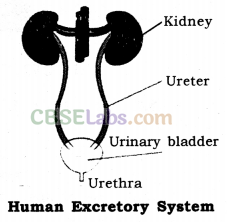
Excretory system of human beings includes :
- A pair of kidneys.
- A urinary bladder.
- A pair of the ureter.
- A urethra.
Kidney:
- Kidney is a bean-shaped organ which lies near the vertebral column in the abdominal cavity.
- The kidney is composed of many filtering units, called nephrons.
- Nephron is called the functional unit of kidney.
Nephron
- It is composed of a tangled mess of tubes and a filtering part, called glomerulus.
- The glomerulus is a network of blood capillaries to which renal artery is attached.
- The artery which takes blood to the glomerulus is called afferent arteriole and the one receiving blood from the glomerulus is called efferent arteriole.
- The glomerulus is enclosed in a capsule like portion, called bowman’s capsule. The bowman’s capsule extends into a fine tube which is highly coiled.
- Tubes from various nephrons converge into collecting duct, which finally goes to the ureter.
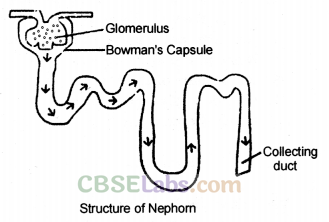
Urine formation in the kidney: The urine formation involves three steps:
- Glomerular filtration: Nitrogenous wastes, glucose, water, amino acid filter from the blood into bowman’s capsule of the nephron.
- Tubular reabsorption: Now, useful substances from the filtrate are reabsorbed back by capillaries surrounding the nephron.
- Secretion: Extra water, salts are secreted into the tubule which opens up into the collecting duct and then into the ureter.
Urine produced in the kidneys passes through the ureters into the urinary bladder where it is stored until it is released through the urethra.
The purpose of making urine is to filter out waste product from the blood i.e., urea which is produced in the liver.
Haemodialysis: The process of purifying blood by an artificial kidney. It is meant for kidney failure patient.
Excretion in Plants
- Other wastes may be stored in leaves, bark etc. which fall off from the plant.
- Plants excrete some waste into the soil around them.
- Gums, resin → In old xylem
- Some metabolic wastes in the form of crystals of calcium oxalates in the leaves of colocasia and stem of Zamikand.
Nutrition in Plants and Animals
Nutrition: Process of obtaining and utilizing of food is known as nutrition.
Mode of nutrition:
- Autotrophic Nutrition (All green plants)
- Heterotrophic Nutrition (Animals, Man, Non-green plants)
- Saprotrophic nutrition
- Parasitic nutrition
- Holozoic nutrition
Autotrophs: It is a mode of nutrition in which organisms can make their own food from simple raw material. Example, all green plants.
Heterotrophs: It is a mode of nutrition in which organisms cannot prepare their food on their own and depend on others. Example, animals.
Saprotrophic Nutrition: It is the process by which the organism feeds on dead and decaying matter. Example, Rhizopus, Mucor, yeast.
Photosynthesis: It is the process by which green plants prepare their own food.
Raw materials for photosynthesis:
- Water and Minerals: These are absorbed by the roots from the soil.
- Carbon dioxide: Carbon dioxide enters the leaves through tiny pores called stomata.
- Sunlight: Energy from the sun is called solar energy.
- Chlorophyll: Chlorophyll pigment helps leaves to capture solar energy.
Products of Photosynthesis: Carbohydrate-glucose- It is converted to starch.
Symbiotic relationship: Two organisms live in a close association and develop a relationship that is beneficial to both this is called a symbiotic relationship.
Example, Lichen is a living partnership between a fungus an alga. Fungus absorbs water and provides shelter and alga prepare food by photosynthesis
Insectivores: Plants feed on insects for their nitrogen requirements.
Holozoic nutrition: It means feeding on solid food. Organism takes complex organic food into the body. Example, man, amoeba, dog, etc.
- Herbivores: Animals which feed on plants only. Example, deer, cow.
- Carnivores: Animals which feed on flesh or meat. Example, tiger.
- Omnivores: Animals which feed on both plant and flesh. Example, man, dog.
Steps of Holozoic nutrition:
- Ingestion: Taking food into the mouth.
- Digestion: Break down of large insoluble food into small water-soluble molecules by enzymes.
- Absorption: Digested food absorbed through the intestinal wall into the blood.
- Assimilation: Absorbed food is taken by body cells for releasing energy, growth and repair.
- Egestion: Eliminating undigested food from the body.
Digestive organs of human beings: Mouth, oesophagus, stomach, small intestine and large intestine with glands like salivary gland, liver, pancreas.
Teeth: An organ which breaks down the complex food and helps in chewing the food.
- Milk teeth: The first set of 20 small teeth when the baby is 6-7 months old.
- Permanent teeth: The second set of 32 larger teeth, when a child is 6-7 years old and comes by replacing milk teeth.
Enamel: A white, strong, shining, protective material covering on teeth.
Tongue: A muscular organ attached to the floor of the buccal cavity which helps in tasting and mixing the food with saliva for digestion.
Transportation in Plants and Animals
- Vascular tissue: A plant tissue which helps in transportation.
- Xylem tissue: It helps in transporting water and minerals in plants.
- Phloem: It helps in transporting food in plants.
- Translocation: The process of transporting food from leaves to other parts of plants.
- Transpiration: A loss of water from stomata in leaves.
- Blood: A red colour fluid which circulates in the body of animals.
- Plasma: Fluid part of the blood which consists of nutrients, hormones, and waste products.
- Blood vessel: Tube-like structure present in the body for carrying blood inside the body.
- Artery: It carries oxygenated blood from the heart to body parts.
- Vein: It carries deoxygenated blood from body parts to the heart.
- Capillary: A thin-walled narrow tube which connects artery and vein.
- Heart: A muscular organ present in the thoracic cavity and helps in pumping blood in the body.
- Double circulation: A circulatory system in which blood travels twice through the heart in one complete cycle.
- Heartbeat: One complete contraction and relaxation of the heart (72 times in a minute).
- Stethoscope: Instrument which measures heartbeat.
- Systolic pressure: Maximum pressure at which blood flows during contraction of the heart. (120 mm Hg)
- Diastolic pressure: Minimum pressure at which blood flows during relaxation of the heart. (80 mm Hg)
- Sphygmomanometer: Instrument which measures blood pressure.
- Lymph: A light yellow liquid flowing from body tissue to the blood circulatory system and provides immunity.
Excretion in Plants and Animals
- Excretion: It is the process of removing waste products from the body.
- Excretory products of plants: CO2, O2, water vapour, peel of bark, fruits, leaves, gum, raisin, etc.
- Excretory products of humans: Carbon dioxide, urea, etc.
- Kidney: Organ which removes the toxic substance urea from blood and filters it.
- Urine: A yellowish liquid which contains water and urea.
- Dialysis: The procedure used for cleaning the blood of a person in case of kidney failure.
- Nephron: Functional unit of excretory system present in the kidney for filtering blood.
- Renal Artery: Blood vessels which bring blood from heart to kidney.
- Renal Vein: Blood vessel which brings blood from kidney to heart.
NCERT Exemplar Class 10 Science Chapter 6 Life Processes
Short Answer Type Questions
1.“All plants give out oxygen during day and carbon dioxide during night”. Do you agree with this statement? Give reason.
Answer.Yes, respiration takes place throughout the day and night but photosynthesis takes place only during day time. During day time, as the rate of photosynthesis is more than the rate of respiration, the net result is evolution of oxygen. At night there is no photosynthesis, so they give out carbon dioxide due to respiration.
2.How do the guard cells regulate opening and closing of stomatal pores?
Answer.The swelling of guard cells due to absorption of water causes opening of stomatal pores while shrinking of guard cells closes the pores. Opening and closing of stomata occurs due to turgor changes in guard cells. When guard cells are turgid, stomatal pore is open while in flaccid conditions, the stomatal aperture closes.
3.Why do fishes die when taken out of water?
Answer.Fishes respire with the help of gills. Gills are richly supplied with blood capillaries and can readily absorb oxygen dissolved in water. Since fishes cannot absorb gaseous oxygen from the atmosphere they die soon after they are taken out of water.
4.Is ‘nutrition’ a necessity for an organism? Discuss.
Answer.Food is required for the following purposes:
(i) It provides energy for the various metabolic processes in the body.
(ii) It is essential for the growth of new cells and repair or replacement of worn out cells.
(iii) It is needed to develop resistance against various diseases.
5.What would happen if green plants disappear from earth?
Answer.Green plants are the sources of energy for all organisms. If all green plants disappear from the earth, all the herbivores will die due to starvation and so will the carnivores and then the decomposers.
6. What are the adaptations of leaf for photosynthesis?
Answer.
(i) Leaves provide large surface area for maximum light absorption.
(ii) Leaves are arranged at right angles to the light source in a way that causes overlapping.
(iii) The extensive network of veins enables quick transport of substances to and from the mesophyll cells.
(iv) Presence of numerous stomata for gaseous exchange.
(v) The chloroplasts are more in number on the upper surface of leaves to absorb more light energy.
7.Why is small intestine in herbivores longer than in carnivores?
Answer. Digestion of cellulose takes a longer time. Hence, herbivores eating grass need a longer small intestine to allow complete digestion of cellulose. Carnivorous animals cannot digest cellulose, hence they have a shorter intestine.
8.What will happen if mucus is not secreted by the gastric glands?
Answer. Gastric glands in stomach release hydrochloric acid, enzyme pepsin and mucus. Mucus protects the inner lining of stomach from the action of hydrochloric acid and enzyme pepsin. If mucus is not released, it will lead to erosion of inner lining of stomach, leading to acidity and ulcers.
9.What is the significance of emulsification of fats?
Answer. Fats are present in food in the form of large globules which makes it difficult for enzymes to act on them. Bile salts present in bile break them down mechanically into smaller globules which increases the efficiency of fat digesting enzymes lipase.
10.Why does absorption of digested food occur mainly in the small intestine?
Answer. Maximum absorption occurs in small intestine because:
(a) Digestion is completed in small intestine.
(b) Inner lining of small intestine is provided with villi which increases the surface area for absorption.
(c) Wall of intestine is richly supplied with blood vessels (which take the absorbed food to each and every cell of the body).
11.What is the advantage of having four chambered heart?
Answer.In four chambered heart, left half is completely separated from right half by septa. This prevents oxygenated and deoxygenated blood from mixing. This allows a highly efficient supply of oxygenated blood to all parts of the body. This is useful in animals that have high energy needs, such as birds and mammals and maintain body temperature.
12. Mention the major events during photosynthesis.
Answer. The major events during photosynthesis are:
(i) Absorption of light energy by chlorophyll.
(ii) Conversion of light energy to chemical energy.
(iii) Splitting of H2O into H2, O2 ”
(iv) Reduction of CO2to carbohydrates.
13. Name the energy currency in the living organisms. When and where is it produced?
Answer. Adenosine triphosphate (ATP) produced during respiration in living organisms
and also during photosynthesis in plants.
14. What is common for cuscuta, ticks and leeches?
Answer. All are parasites, they derive nutrition from plants or animals without killing them.
15. Explain the role of mouth in digestion of food.
Answer.
(i) Food is crushed into small pieces by the teeth.
(ii) Tongue helps in thorough mixing of food with saliva and the enzyme amylase (found in saliva) breaks down starch into sugars.
16. What are the functions of gastric glands present in the wall of the stomach?
Answer.
(i) Production of pepsin enzyme that digests proteins.
(ii) Secretion of Mucus for protection of inner lining of stomach.
17. Name the correct substrates for the following enzymes
(a) Trypsin (b) Amylase (c) Pepsin (d) Lipase
Answer. (a) Protein (b) Starch (c) Protein (d) Fats
18. What will happen if platelets were absent in the blood?
Answer. In the absence of platelets, the process of clotting will be affected. When cut, the blood will not stop oozing out.
19. Plants have low energy needs as compared to animals. Explain.
Answer. Plants do not move. In a large plant body there are many dead cells like schlerenchyma as a result it requires less energy as compared to animals. Animals need more energy as they have to move in search of food, shelter and mates.
20. Why and how does water enter continuously into the root xylem?
Answer. Cells of root are in close contact with soil and so actively take up ions. The ion- concentration, increases inside the root and hence osmotic pressure increases the movement of water from the soil into the root which occurs continuously. Transpiration also plays a big role in causing, osmotic pressure.
21.Why is transpiration important for plants?
Answer.Transpiration is important because:
(i) it helps in absorption and upward movement of water and minerals from roots to leaves
(ii)it prevents the plant parts from heating up.
Long Answer Type Questions
1.Explain the process of nutrition in Amoeba.
Answer.The mode of nutrition in amoeba is Holozoic, and the process of obtaining food by amoeba is called phagocytosis. The different processes involved in the nutrition of amoeba are:
(i) Ingestion: Ingestion is the process of taking food in the body. Amoeba is a unicellular animal, so it doesn’t have a mouth for ingestion of food. Amoeba ingests the food by encircling it by forming pseudopodia. When the food is completely encircled, the food is engulfed in the form of a bag called food vacuole.
(ii)Digestion: Digestion is the process of breaking the large and insoluble molecules in small and water soluble molecules. In amoeba, several digestive enzymes react on the food present in the food vacuoles and break it down into simple and soluble molecules.
(iii) Absorption: The food digested by digestive enzymes is then absorbed in the cytoplasm by the process of diffusion. While the undigested food remains in the food vacuole. If a large amount of food is absorbed by amoeba, the excess food is stored in the cytoplasm in the form of glycogen and lipids.
(iv) Assimilation: During this step the food absorbed by the cytoplasm is used to obtain energy, growth and repair. This process of utilizing absorbed food for obtaining energy, repair and growth is called assimilation.
(v) Egestion: When sufficient amount of undigested food gets collected in the food vacuole, it is thrown out of the body by rupturing cell membrane. The process of removal of undigested food from the body is called egestion.
2. Describe the alimentary canal of man
Answer.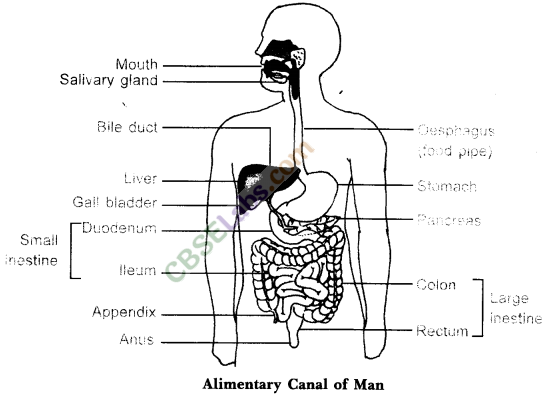
(i)Mouth: Food is ingested (the taking in of food or liquid into the body), chewed and swallowed. It is softened by chemicals in saliva (spit). When you swallow, food travels down the oesophagus into the stomach. The food that leaves the mouth is called bolus.
(ii) Stomach: The stomach is a bag with a muscular wall. It mashes food into a pulp, helped by chemicals called gastric juices. When empty it is about 0.5L in size, but when it is full after a meal it can stretch to 4L in size. Food that leaves the stomach is called chyme. It passes into the small intestines after about 4 hours of eating.
(iii) Small intestine: It is a 6 meter long tube where chyme is further broken down. Carbohydrates and fat are broken down and absorbed through the intestine walls into the blood.
(iv) Large intestine: Food that can’t be digested passes into the large intestines. It is then pushed towards the anus where it is excreted as feces.
3.Explain the importance of soil for plant growth.
Answer. Materials required for plant growth are obtained from soil, e.g. Nitrogen, Phosphorus, other minerals and water. They have to be transported to long distances depending upon the size of the plants. Xylem moves water and minerals from soil to aerial parts. Soil also helps in anchoring plant, availability of oxygen for respiration of root cells and symbiotic association with microbes.
Extra Questions for Class 10 Science Chapter 6 Life Processes
According to new CBSE Exam Pattern, MCQ Questions for Class 10 Science pdf Carries 20 Marks.
Topics and Subtopics in NCERT Solutions for Class 10 Science Chapter 6 Life Processes:
Question-1
Define nutrition? What are the different modes of nutrition?
Solution:
Nutrition is the process of intake, as well as utilization of nutrients by an organism. The different modes of nutrition are saprophytic nutrition, parasitic nutrition and holozoic nutrition.
Question-2
What is the mode of nutrition in fungi?
Solution:
Saprophytic nutrition is the mode of nutrition that is seen in fungi.
Question-3
Name the pigment, which can absorb solar energy.
Solution:
Chlorophyll is the pigment, which can absorb solar energy.
Question-4
Name the two stages in photosynthesis.
Solution:
The two stages in photosynthesis are
(i) Light reaction and
(ii) Dark reaction.
Question-5
Name the factors, which affect photosynthesis.
Solution:
The factors which affect photosynthesis, are light, water, temperature, humidity, age of the leaf and carbon dioxide.
Question-6
Define a herbivore and a carnivore.
Solution:
The animals that feed only on plants are called herbivores.
The animals that feed only on flesh are called carnivores.
Question-7
How does amoeba engulf its food?
Solution:
Amoeba engulfs its food by extending pseudopodia. This process is known as Phagocytes.
Question-8
Name the parts of the digestive system of a grasshopper.
Solution:
The parts of digestive system of a grasshopper are pharynx, salivary glands, hepatic caeca, malpighian tubules, ileum, colon, rectum and anus.
Question-9
What are the functions of the liver and the pancreas?
Solution:
The liver secretes bile, which contains bile pigments and bile salts. The bile secreted by the liver cells is normally stored in the gall bladder, until needed in the duodenum. Pancreas lie parallel to and beneath the stomach. It is a large gland, which secretes digestive enzymes as well as the hormones, insulin and glucagons. Both bile and pancreatic juice enter duodenum through a common duct. Bile emulsifies fat present in the food. Pancreatic juice contains trypsin, for digesting proteins and pancreatic amylase for the breakdown of starch.
Question-10
Define breathing.
Solution:
Breathing is a process by which organisms inhale oxygen. The inhaled oxygen gets diffused into the blood and the carbon dioxide from the blood diffuses back into the alveoli from where it is exhaled.
Question-11
How is respiration different from breathing?
Solution:
Respiration is a complex process, which includes breathing, the mechanism of exchange of gases,oxygen and carbon dioxide and oxidation of digested food occurring in the cells in order to release energy. The main outcome of respiration is the release of energy through oxidation of simple food molecules such as glucose.
Question-12
In which kind of respiration is more energy released?
Solution:
In aerobic respiration more energy is released.
Question-13
Which part of the roots is involved in exchange of respiratory gases?
Solution:
Root hair is the part of the root which is involved in exchange of respiratory gases.
Question-14
What are (i) stomata and (ii) lenticels?
Solution:
(i) Stomata are tiny apertures found on the surface of the leaf, which regulate the exchange of respiratory gases and transpiration.
(ii) Lenticels are the raised pores in the woody plants that allow the exchange of gases between the atmosphere and the internal tissues.
Question-15
Give two points of differences between respiration in plants and respiration in animals.
Solution:
The respiration in plants differ from respiration in animals in two respects, they are
(i) There is minimal transport of gases from one part of the plant to another, unlike the animals.
(ii) Plant respiration occurs at a much slower rate than animal respiration.
Question-16
Name the respiratory organs of
(i) fish
(ii) mosquito
(iii) earthworm
(iv) dog
Solution:
The respiratory organs of
(i) fish – gills
(ii) mosquito – tracheoles
(iii) earthworm – skin
(iv) dog – lungs.
Question-17
Solution:
The oxygen rich air enters through openings called spiracles situated on the sides of the body of an insect. Spiracles open into tracheal system. Trachea branch into tracheoles, which reach the cells. Thus, every cell gets oxygen directly. Carbon dioxide released by cells moves out through the spiracles.
Question-18
From where do the following take in oxygen?
(i) prawn (ii) rat.
Solution:
(i) Prawns take in oxygen that is dissolved in water.
(ii) Rat takes in oxygen from the atmosphere.
Question-19
State the function of epiglottis.
Solution:
Epiglottis prevents the food from entering into the trachea.
Question-20
Solution:
The walls of trachea do not collapse when there is less air in it, because, they are supported by rings of cartilage.
Question-21
Solution:
Nutrition is the sum of all those activities which are concerned with ingestion, digestion, absorption of digested food, egestion, oxidation of simple food to produce energy for growth, development and maintenance of living organism.
Question-22
Solution:
Energy is required by an organism even during sleep because various biological processes keep on occurring in its body.
Question-23
Define photolysis.
Solution:
The phenomenon of breaking down of water in the illuminated chloroplast is known as photolysis.
Question-24
What are the living organisms that cannot make their own food called?
Solution:
The living organisms that cannot make their own food called heterotrophs.
Question-25
What are chemotrophs?
Solution:
Chemotrophs are organisms, which do not require light. They manufacture their food from inorganic substances in the presence of energy derived from the oxidation of simple inorganic compounds of iron, sulphur, etc.
e.g. bacterium Nitrosomonas.
What is compensation point?
Solution:
The compensation point is the amount of light on the light curve where the rate of photosynthesis exactly matches the rate of respiration.
At this point, the uptake of CO2 through photosynthetic pathways is exactly matched to the respiratory release of carbon dioxide, and the uptake of O2 by respiration is exactly matched to the photosynthetic release of oxygen. This point is reached during early mornings and late evenings.
Other than chlorophyll, which other pigment is necessary for photosynthesis?
Solution:
Carotenoids are the pigments, which are necessary for photosynthesis other than chlorophyll. Carotenoids are yellow, orange, red or brown pigments, which absorb sunlight and pass this energy on to chlorophyll for the purpose of photosynthesis. Thus, the carotenoids themselves do not carry out photosynthesis but help in photosynthesis.
Question-28
Where does digestion begin?
Solution:
Digestion begins from the mouth.
Question-29
What is the name given to the process of using the absorbed food for producing energy?
Solution:
The name given to the process of using the absorbed food for producing energy is assimilation.
Question-30
What happens to visible light of the Sun when it falls on chlorophyll?
Solution:
Visible light of the Sun consists of seven colours, namely, violet, indigo, blue, green, yellow, orange and red. Out of these lights of different wave lengths, chlorophyll absorbs mainly blue, violet, red and orange lights but does not absorb the green light. It is due to the reflection of green light by the chlorophyll that the plant looks green in colour.
NCERT Solutions for Class 10 Science All Subject NCERT Solutions
- Chapter 1 Chemical Reactions and Equations
- Chapter 2 Acids, Bases and Salts
- Chapter 3 Metals and Non-metals
- Chapter 4 Carbon and Its Compounds
- Chapter 5 Periodic Classification of Elements
- Chapter 6 Life Processes
- Chapter 7 Control and Coordination
- Chapter 8 How do Organisms Reproduce?
- Chapter 9 Heredity and Evolution
- Chapter 10 Light Reflection and Refraction
- Chapter 11 Human Eye and Colourful World
- Chapter 12 Electricity
- Chapter 13 Magnetic Effects of Electric Current
- Chapter 14 Sources of Energy
- Chapter 15 Our Environment
- Chapter 16 Management of Natural Resources
.png)
.png)